Reverend Samuel Wickham Mills’ Genealogical Research
This section presents some of the extensive research into the Mills genealogical record done by Reverend Samuel Wickham Mills (05 Apr 1820 to 22 Nov 1902) of Orange County NY. Biographical information on Reverend Mills is also presented, along with details of Horatio W. Mills’ death in the Seawanhaka disaster. Both of these Mills are descended from Timothy Mills of Mills Pond, and they are in the same generation as Edward H. Mills’ father Jonas.
“Suffice it to say that the life of our community is on a distinctly higher plane today than it otherwise would have been, because in the Providence of God he lived in it.”
“Christ law he preached, but first he followed it himself.”
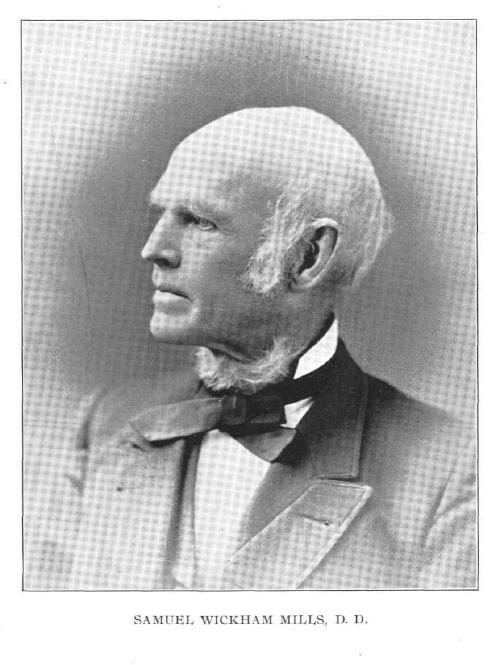
SAMUEL WICKHAM MILLS, D. D.
— 1895, Portrait and biographical record of Orange county, New York. Chapman Publishing Company, Chicago IL, p844, familysearch.com. View largest available size.
SAMUEL WICKHAM MILLS, D.D., one of the highly respected citizens of Port Jervis, is a native of Orange County, born in the town of Wallkill, near Scotchtown, five miles north of Middletown, on the 5th of April, 1820, and is a son of Samuel and Esther (Stitt) Mills. His mother was a daughter of John and Nancy (McCullough) Stitt, of Bloomingburg, Sullivan County, N. Y. The Mills family came from Yorkshire, England. Some of the name are of Holland extraction, the first to come to America being Peter Vander Mulin (the name meaning “from the mills”), who settled in Windsor, Conn., where the family took the English name of Mills. The English family can be traced back to the De Molis, founded in 1083, in Devon, England, the name being derived from Meulles of Normandy. Members of the family bearing that name went to England with William the Conqueror in 1066. The name has several times been changed, being Milne in 1530, Mills in 1560, Millne in 1584, Milles in 1612, and Mylle from 1627.to 1665, these being found in the records of Yorkshire, England.
John Mills came with Governor Winthrop to Massachusetts in 1629 or 1630, his name appearing thirty-third on the roll of the first church of Boston, in which church his two daughters, Joy and Remembrance, were baptized in October, 1630. He became a freeman of Boston in 1632, but later removed to Braintree, Mass., where he served as Township Clerk in 1653. His will was made in 1670, and he left his estate to his son John, asking also that one of John’s sons be educated for the ministry, as many of his predecessors were of that profession. Richard Mills was a pioneer schoolmaster on Long Island and in Connecticut. Samuel Mills, of Dedham, Mass., and Samuel Mills, of Windsor, Conn., came from England at an early date, but it is not known whether they were related to the branch of the family to which our subject belongs. George Mills, who was probably the ancestor of the Long Island branch, came from Yorkshire, England, about 1665, and died in Jamaica, L. I., in 1694, at the age of eighty-nine years. He is supposed to have been a brother of John Mills, of Boston.
From George, in a direct line to our subject, are Samuel, Jonathan, Timothy, Jonathan, Jacob and Samuel, the latter the father of our subject. George’s son Samuel was born on Long Island in 1631, and died in Jamaica, L. I., in 1726, at the age of ninety-five, a notice of his death appearing in the New York Gazette, March 12, 1726. He had sixteen children, nine of whom were living at the time of his death, together with eighty grandchildren and fifty-four great-grandchildren. His son Jonathan was born at Jamaica, N. Y., was married in 1710, and had four children: Timothy, Samuel, Isaac and Jonathan. The records show that he purchased a piece of land March 3, 1677. Timothy, born in 1677, left Jamaica and settled at Mills’ Pond in 1693, to which he gave the name. He died March 30, 1751. His first wife, Elizabeth, had two children, and the second wife, Sarah, had eleven. Jonathan, the sixth ‘of the latter marriage, was born October 23, 1710, and was married in 1737 to Ruth Rudyard, of Perth Amboy, N. J. They had six children, and after her death he was again married, January 25, 1756, this time to Dorothy Miller, and to them were born three children. His death occurred at Mills’ Pond, October 23, 1798. Of the first marriage, Jacob and Timothy were twins, born December 22, 1746.
At the age of nineteen Jacob Mills began whaling, which he followed for six or seven months out of the year. He came to Orange County between 1768 and 1770, near New Windsor, and started a tannery. When he first moved here he bought twenty-two hundred and fifty acres of land in the town of Wallkill, five miles north of Middletown, and the place was known as Millsburg. On the 27th of December, 1773, he was married, in Goshen, to Catherine Denton. During the Revolutionary War he made shoes for the soldiers of the militia company to which he belonged, and received his pay in Continental money, which was worth but very little. His company was ordered to Ft. Montgomery, but it was captured before they arrived. His tannery was enlarged, and in 1791 he built a stone house near the same, and there our subject was born. He occupied that house until 1807, when he erected a large frame dwelling. He died at the home of his son Charles, in 1841, at the age of ninety-five years. He was quite a liberal man, and assisted largely in building the Presbyterian Church at Scotchtown. In his family were twelve children, six sons and six daughters, and with the exception of Catherine all reared families of their own. William Wickham was the only one that did not live in Orange County. He made his home on Long Island, where he was heir to his uncle’s property at Mills’ Pond. At the time of his death Jacob Mills had ninety-seven grandchildren, forty-eight grandsons and forty-nine granddaughters, nearly all of whom became farmers. There was one physician, one clergyman, and one Sheriff of Orange County.
Samuel Mills, the father of our subject, succeeded to the old home place. He was born August 27, 1776, and died on the 13th of November, 1860, at the age of eighty-five. He cast his last vote just before his death. On the 13th of January, 1807, he married Esther Stitt, who was born August 28, 1787, and her death occurred November 11, 1863. Of their family we note the following: Catherine married Archibald Slaughter, and died June 8, 1888, in her eighty-first year; Nancy, wife of Hiram S. Dunning, died in her thirty-fourth year, March 3, 1843; William died October 31, 1885, at Petersburg, Va., in his seventy-sixth year; Caroline, wife of DeWitt Slaughter, died November 9, 1861, in her fiftieth year; Mary Jane, the wife of Robert J. Bull, of Wallkill, is now in her eighty-first year; John Stitt died when young; Sarah Elizabeth, who was the wife of Gen. Alfred D. Hurtin, died April 24, 1886, in her seventieth year; Jacob Stitt passed away when young; Samuel Wickham is next in order of birth; James Jackson lives at Scotchtown; Albert died on the old homestead in his sixty-sixth year, July 25, 1890, where his widow still resides; Edwin lives near Phillipsburg, this county; and Ruth died in childhood. The father of this family carried on a tannery and also engaged in farming, owning a large tract of land, which comprised three farms. He was quite a successful business man, and assisted his children very materially.
We now come to the personal history of Rev. Samuel Wickham Mills. He was the ninth in the family, and remained at home until reaching the age of fifteen, when he entered Rutgers College at New Brunswick, N. J., from which he was graduated in the Class of ’38, at the age of eighteen. He then began studying in the Theological Seminary of the Reformed Church at New Brunswick, from which he was graduated in 1842. Among his classmates at Rutgers there were many who afterward became quite noted, among them being John DeWitt, who became Professor of Ancient Languages at the Theological Seminary at New Brunswick; Theodoric R. Westbrook, Supreme Judge of New York, who made his home at Kingston, this state, and died while serving on the Bench; and Dr. James A. H. Cornell, a minister of New Baltimore, N. Y., who has been quite prominent in church work in the state. Upon his graduation from college he was awarded the English salutatory, which at that time was third in the list of honors conferred by the faculty of the college.
At Bloomingburg, Sullivan County, in May, 1843, Mr. Mills was ordained and began his pastoral work. At the end of fifteen years he located at Port Jervis, where he engaged in preaching for fourteen years, or until 1872, the date of his arrival here being in February, 1858. He here erected the present Reformed Church edifice at a cost of $44,000, one of the, principal contributors being Henry H. Farnham, who gave $13,000, besides a fine organ. The architect was Isaac G. Perry, the present Capital Commissioner of Albany, and a noted man. Rev. Mr. Mills was very fortunate in the erection of the church, as the entire amount of its construction was obtained before the dedication. During his ministry here he received two hundred and forty-nine-members into the church. Of late he has had no charge, but does supply duty, and has preached in nearly all of the churches in this section of the country. He is a member of the classis of Orange, in the higher judicatories of the Reformed Church, and during his pastorates, as well as since, has represented the same. He gives entire satisfaction wherever he goes, and is an untiring worker among all classes. He has served as President of the Minisink Valley Historical Society since its organization in 1889. For thirty-seven years, or up to June, 1895, he was Corresponding Secretary of the Orange County Bible Society, and then was made President of the society.
Rev. Mr. Mills was married, on the 17th of January, 1844, to Miss Almeda J. Bailey, a daughter of Nathaniel Bailey, of Middletown, and a sister of Daniel H. Bailey, later Mayor of the same city. She was born February 28, 1822, and her death occurred on the 12th of March, 1867. By her marriage she became the mother of six children: Harriet Bailey, who died in childhood on the 2d of April, 1847; Esther, the wife of C. E. Cuddeback, an attorney of Port Jervis; Anna, whose death occurred April 5, 1879, at the age of twenty-nine years; Theodore Denton, a doctor of Middletown; Cornelia Hunter, who died November 24, 1871, at the age of seventeen years; and Mary Delia, wife of J. Alex Stitt, an attorney of New York City. On the 29th of November, 1870, Rev. Mr. Mills was again, married, Miss Amira St. John becoming his wife. She is a daughter of Stephen St. John, of Port Jervis.
Mr. Mills is a well read, cultured gentleman, and a natural pulpit orator. His record has been an honorable one, his years have been fruitful with deeds of usefulness and kindness, with malice towards none and friendliness towards all who have come under his influence, and he has gained the respect and honor of the whole community. He is now living in his handsome residence on the main street of Port Jervis, lying at the foot of the mountain, which looms grandly above it for several hundred feet, and is surrounded by beautiful grounds. In this lovely spot he intends to spend his remaining days.
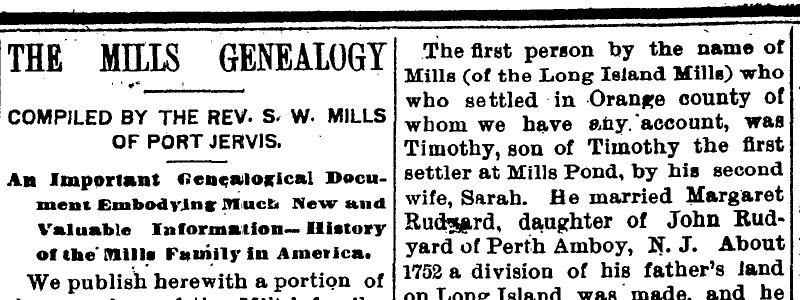
THE MILLS GENEALOGY
COMPILED BY THE REV. S. W. MILLS OF PORT JERVIS.
An Important Genealogical Document Embodying Much New and Valuable Information—History of the Mills Family in America.
We publish herewith a portion of the genealogy of the Mills’ family, which was compiled by Rev. Dr. S. W. Mills, of this village and read at the meeting of the M. V. H. S., at Glenette, Saturday, June 21. It embodies much information in regard to that family not hitherto made public. The remainder of the article will appear in tomorrow’s UNION.
The name of Mills, which is found in so many parts of our country, appears to be chiefly of English origin. There are those who bear the name who are of Holland extraction. In the early settlement of New England there was one Peter Water Van der Mulin, who emigrated from Holland and settled at Windsor, Conn., and took the English name of Mills. (The English of Van der Mulin is from the Mills). This same name is found among the earlier settlers of Hartford, Conn. Of his descendants we know nothing, but it is quite probable there are those living who can trace their ancestry back to him.
Of those of English extraction we know more. The name of Milnes or Mills, otherwise De Molis, was found in Devon, England, in 1083 6. It was derived from Meulles, Normandy. It is supposed to have been brought there in the time of William the Conquerer, who introduced the Norman language into England about 1066. Lord Haughton (Milne) has been a member of Gladstone’s Cabinet in this year, 1894. Under the various forms of Mill, Mills, Milne, Milles and Mylles, the naine is found in Yorkshire in 1530, 1560, 1584, 1612, 1627 and 1665. In Sussex county. England, it appears as follows: Geffry ‘Atte Milne 1307-27; Agnes ‘Atte Milne’, John ’Atte Mull’ alias Mill, Lord of Gretham 1366 ; Robert ‘Atte Mulle’ alias Mills of Gilford, Surry county, 1377-1399 ; John ’Atte Mille’ of Pullborough, 1366 ; Robert Mill of Sussex 1422-1461; John Mylle 1578 ; Sir Richard Mill (b) 1690.
The first emigrant by the name of Mills from England of whom we have knowledge was John Mills, who came over in the fleet with Gov. Winthrop in 1629 or 1630. His name stood No. 33 on the roll of the first church in Boston, where two of his daughters (Joy and Remembrance) were baptised in October, 1630. He was made freeman in Boston, March 6, 1632. He resided there ten years and then removed to Braintree, Mass., where in 1653 he was clerk of Braintree. In his will made June 1670, he expresses the wish that his son John, to whom he gave his estate, “would bring up one of his sons to the ministry, as this had been the calling of his predecessors to the third if not the fourth generation.”
There was one Richard Mills who was called the “Pioneer Schoolmaster” of New York, who lived on Long Island and in Connecticut ; Samuel Mills, who lived at Dedham, Mass., and Samuel Mills, who lived at Windsor, Conn., all of whom came from England at a very early date, but the precise year not known. How they were related and who were their descendants we have not learned.
George Mills was probably the ancestor of the Long Island Mills. He came from Yorkshire, England, and was born about 1605, and died at Jamaica, L. I., Oct. 17, 1694, aged 89 years, His name is found on the town records of Hempstead and Jamaica in Feb. 16, 1656, and Nov. 25, 1656, when he was granted a home lot in each town. Some have supposed that this George was a brother of John, who came over with Gov. Winthrop, but no proof of the fact has yet been found.
Samuel, a son of George, was born in this country in 1631, and died at Jamaica in March, 1726, aged 95. A notice of his death appeared in the N. Y. Gazette of March 12, 1726, in which it was stated that he was able to do a good day’s work but a few days before he died. He had 16 children, nine of whom were living at the time of his death, 80 grandchildren and 54 great grandchildren.
Jonathan Mills, who lived at Jamaica, and whose wife was Martha, was probably the son of George. The date of his birth and death are not known. On March 30. 1677, he bought of Jonas Halstead and his son Joseph, a piece of land owned by them jointly. His wife, Martha, was living in 1710, as well as himself. They had four children, Timothy, Samuel, Isaac and Jonathan, jr. Of these, Timothy was born in 1667, and moved from Jamaica to Mills’ Pond, four mils from Smithtown, in 1693, the first of the name to locate there, and where he died March 30, 1751. By his first wife, Elizabeth, he had two children, and by his second, Sarah, eleven. Of these eleven the sixth was Jonathon, who was born Oct. 23, 1710, who was the father of Jacob Mills, Windsor, born Dec 22, 1746, and who subsequently settled in the town of New Windsor, Orange county, N. Y.
Jonathan Mills married April 3, 1737, Ruth. Rudyard, daughter of John Rudyard of Perth Amboy, N. J., by whom he had six children. On January 25, 1756, he married Dorothy Miller, by whom he had three children. He lived at Mills Pond, where he died Oct, 23, 1798, Of the six children by his first wife, Jacob and Timothy were twins.
The first person by the name of Mills (of the Long Island Mills) who settled in Orange county of whom we have any account, was Timothy, son of Timothy the first settler at Mills Pond, by his second wife, Sarah. He married Margaret Rudyard, daughter of John Rudyard of Perth Amboy, N. J. About 1752 a division of his father’s land on Long Island was made, and he appears to have left Mills Pond and to have settled at New Windsor, which was then in Ulster county. His deed, recorded in Ulster county Deeds (F. F. 465), dated May 20, 1754, states that he is of the precinct of Wallkill, in the county of Ulster. He bought for £370 a tract of 571 acres of land from the Garret Schuyler and Hans Ulrick Bindor heirs, who lived in New York. His will was recorded in New York in 1780, in which he mentions his sons, John, Jonathan and Daniel, and his daughters, Joannah and Anah, and also his wife, Margaret. No trace hag been found of the descendants of this Timothy Mills.
— 27 Jul 1894, Port Jervis Union, Port Jervis NY, p3, nyshistoricnewspapers.org. View largest available size.
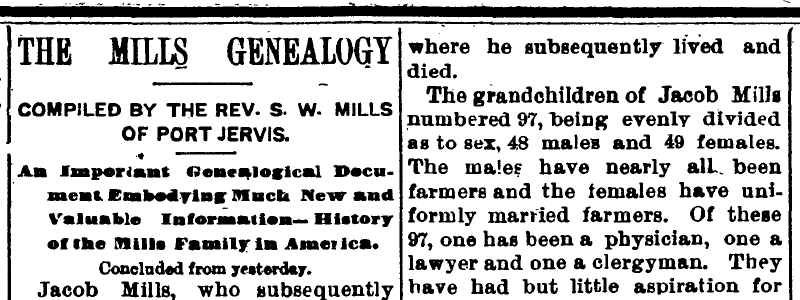
THE MILLS GENEALOGY
COMPILED BY THE REV. S. W. MILLS OF PORT JERVIS.
An Important Genealogical Document Embodying Much New and Valuable Information—History of the Mills Family in America.
Concluded from yesterday.
Jacob Mills, who subsequently settled in New Windsor, was a nephew of the Timothy just mentioned. His father was Jonathan Mills of Mills’s Pond by Ruth Rudyard, his first wife. Jacob and his twin brother were born Dec. 22nd, 1746. Timothy married a Miss Miller and settled in Saratoga county, N. Y. His grandson, Thomas H., lived at Ballston, N. Y., in 1880.
The Mills on Long Island were of English descent and it would seem quite clear that they came from Yorkshire, England, to this country about 1630, locating at first in New England and some of them soon after on Long Island. The Hempstead settlement on Long Island, which began about 1644 and where the name of George Mills was found on the town records, was called a Yorkshire settlement. When Long Island was captured by the English from the Dutch they found on the west end a Yorkshire settlement called Long Island Yorkshire.
When Jacob Mills grew up to manhood, the British law was in force here and the custom of primogeniture in full operation. In accordance with this custom his older brother fell heir to the landed estate while he was taught the trades of tanning and currying and of shoemaking, which in those days were combined together, especially on Long Island. When he was about nineteen years of age he entered upon a series of whaling voyages, going for this purpose in the spring with other young men to Nantucket and from there embarking for Greenland, as it was called, the only whaling fishery then known. These voyages lasted usually six or seven months, when he would return home and work at his trade in the winter, whipping the cat, as it was called, going from house to house. There were no wages on the vessel, but a certain portion of the cash was allotted to each one according to his position. In this way he accumulated quite a little sum during the three voyages made by him, the last one especially being quite successful.
At just what time he came to Orange county, is not known, but it was probably between 1768 and 1770, or when from twenty-two to twenty-four years of age. He bought a tract of land four miles back of New Windsor, built himself a house and started a small tannery, conducting at the same time farming, tanning, currying and shoe-making. He lived here as a bachelor for two or three years until his marriage to Catharine Denton, of Goshen, Dec. 27th, 1773. He was not in the army during the Revolution as his trade was required to furnish shoes for the soldiers. He belonged to a militia company and when the British were coming up the Hudson river to attack Fort Montgomery, his company was suddenly ordered out to march the next morning to the defence of the Fort. He marched with the company after having worked all night to make a pair of shoes for one of the men, who was barefoot. The Fort, however, had been taken by the British before his company reached it.
He furnished, he said, a large number of shoes for the army, but at the close of the war his money was worthless and he had to begin life anew. His place, however, was paid for and he had this advantage.
A few years after the war, the year is not known, he sold his place in New Windsor and bought 2,250 acres in the town of Wallkill, about five miles north of Middletown and moved his family there, the place having been known for many years of late as Millsburgh. The price paid by him for his large tract of land he has been heard to say was thirteen shillings and six-pence happeny per acre in Continental money. Here he started again a tannery consisting at first of but four vats on which he could tan about two-hundred hides, but which was subsequently greatly enlarged. He at first lived on what was known as the Smith place, half a mile or more south-east of the tannery and east of the direct road leading to Scotchtown. In 1791 he built the stone house near the tannery, employing for this purpose a mason from Little Brittian, all the mortar for which building, was carried by his son Samuel, then but fifteen years of age. This house he then occupied until 1807, when he built the large frame dwelling a little north of it in which he lived with his son Charles and where he died in 1841, in the 95th year of his age.
The stone house, tannery and farm connected therewith formerly occupied by him, he gave to his sun, Samuel. He was one of the leading persons in the erection of the Presbyteriam church at Scotchtown. Besides contributing liberally in money for this purpose he kept his team there constantly during the time of its erection.
He had twelve children, six sons and six daughters. Seven of these were probably born in New Windsor. Jacob, jr., was born in Wallkill in 1791, the year in which the stone house was erected. All of these but one, Catharine, were married and had families of their own, All but one, Wm. Wickham, lived and died in Orange county. This one married at Mills Pond, L. I., where he subsequently lived and died.
The grandchildren of Jacob Mills numbered 97, being evenly divided as to sex, 48 males and 49 females. The males have nearly all been farmers and the females have uniformly married farmers. Of these 97, one has been a physician, one a lawyer and one a clergyman. They have had but little aspiration for office or political distinction. Except a town office like that of roadmaster, but one among them all has held anything higher, he having served one term as Sheriff of the county of Orange.
In addition to the Mills who settled in New England and on Long Island, referred to in this sketch, there were emigrants by this name (three, it has been said) who, in the early history of the country, settled in Virginia, and their descendants are to be found in the other southern states. Roger Q. Mills, the present U. S. Senator from Texas, (1894) says that his great grandfather, Charles Mills, lived in Hanover Co., Va. He says that he has met a number of persons by this name from the north, but has been unable to trace any relationship to them, but yet is satisfied that several generations back they all came from the same stock.
— 28 Jul 1894, Port Jervis Union, Port Jervis NY, p2, nyshistoricnewspapers.org. View largest available size.
These two articles were also re-printed as one item in the 02 Aug 1894 edition of the Tri-States Union in Port Jervis NY, p2, which I show here for purposes of comparing the text to the previous two articles.
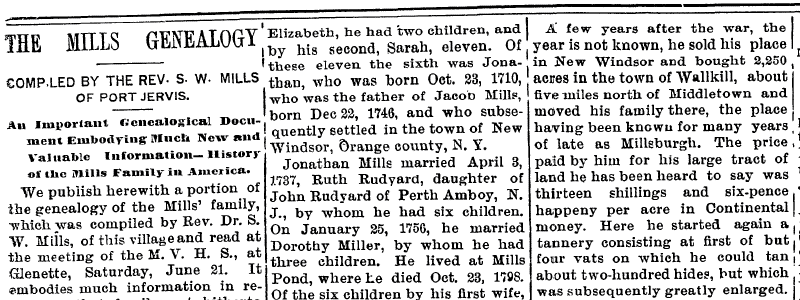
— 02 Aug 1894, Tri-States Union, Port Jervis NY, p2, nyshistoricnewspapers.org. View largest available size.
His obiturary, which republishes significant portions of his Mills genealogical research, filled fully half of the front page of the Tri-States Union:
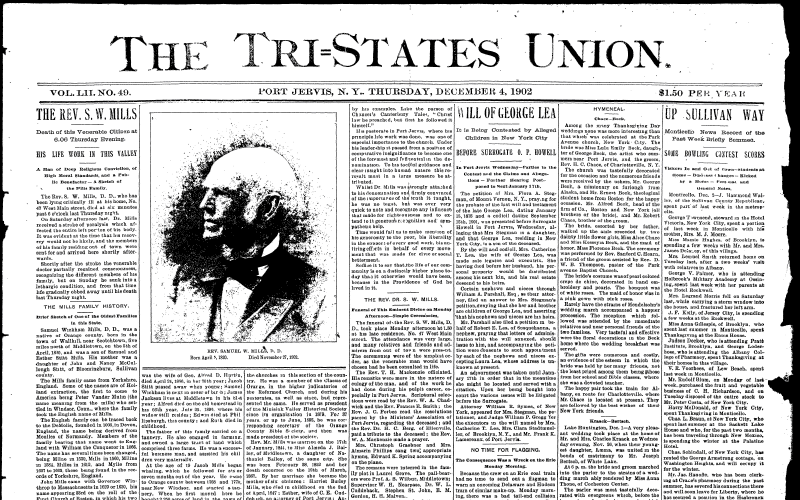
THE REV. S. W. MILLS
Death of this Venerable Citizen at 6.06 Thursday Evening.
HIS LIFE WORK IN THIS VALLEY
A Man of Deep Religious Conviction, of High Moral Standards, and a Public Benefactor — A Sketch of the Mills Family.
The Rev. S. W. Mills, D. D., who bas been lying critically ill at his home, No. 47 West Main street, died at six minutes past 6 o’clock last Thursday night.
On Saturday afternoon last, Dr. Mills received a stroke of paralysis which affected the entire left portion of his body. It was evident at the time that his recovery would not be likely, and the members of his family residing out of town were sent for and arrived here shortly afterwards.
Shortly after the stroke the venerable doctor partially regained consciousness, recognizing the different members of his family, but on Sunday he sunk into a lethargic condition, and from that time life gradually ebbed away until his death last Thursday night.
THE MILLS FAMILY HISTORY.
Brief Sketch of One of the Oldest Families in this State.
Samuel Wickham Mills, D, D., was a native of Orange county, born in the town of Wallkill, near Scotchtown, five miles north of Middletown, on the 5th of April, 1820, and was a son of Samuel and Esther Stitt Mills. His mother was a daughter of John and Nancy McCullough Stitt, of Bloomingburg, Sullivan county.
The Mills family came from Yorkshire, England. Some of the names are of Holland extraction, the first to come to America being Peter Vander Mulin (the name meaning from the mills) who settled in Windsor, Conn., where the family took the English name of Mills.
The English family can be traced back to the DeMolis, founded in 1003, in Devon, England, the name being derived from Meulles of Normandy. Members of the family bearing that name went to England with William the Conqueror in 1066. The name has several times been changed, being Milne in 1530, Mills in 1560, Miline an 1584, Milles in 1612, and Mylle from 1627 to 1665, these being found in the records of Yorkshire, England.
John Mills came with Governor Winthrop to Massachusetts in 1629 or 1630, his name appearing 33rd on the roll of the First Church of Boston, in which his two daughters, Joy and Remembrance, were baptized in October, 1630. He became a freeman of Boston in 1632, but later removed to Braintree, Mass., where he served as Township Clerk in 1653. His will was made in 1670, and he left his estate to his son John, asking also that one of John’s sons be educated for the ministry, as many of his predecessors were of that profession.
Richard Mills was a pioneer on Long Island and in Connecticut. Samuel Mills, of Dedham, Mass., and Samuel Mills, of Windsor, Conn., came from England at an early date, but it is not known whether they were related to the branch of the family to which our subject belongs. George Mills, who was probably the ancestor of the Long Island Branch, came from Yorkshire, England, about 1663, and died in Jamaica, L, I., in 1694, at the age of 89 years, He is supposed to have been a brother of John Mills, of Boston.
From George, in a direct line to our subject, are Samuel, Jonathan, Timothy, Jonathan, Jacob and Samuel, the latter the father of our subject. George’s son, Samuel, was born on Long Island in 1631, and died at Jamaica, L.I., in 1726, at the age of 95 years, a notice of his death appearing in the New York Gazette, March 12, 1726. He had 16 children, nine of whom were living at the time of his death, together with 80 grandchildren and 54 great grandchildren. His son Jonathan was born at Jamaica, N. Y., was married in 1710, and had four children: Timothy, Samuel, Isaac, Jonathan. The records show that he purchased a piece of land March 8, 1677.
Timothy, born in 1677, left Jamaica and settled at Mills Pond in 1693, to which he gave the name. He died March 30, 1751. His first wife, Elizabeth, had two children, and the second wife Sarah, had 11. Jonathan,the sixth of the latter marriage, was born October 23, 1710, and was married in 1737, to Ruth Rudyard, of Perth Amboy, N.J. They had six children, and after her death he was married again, January 25, 1756, this time to Dorothy Miller, and to them were born three children. His death occurred at Mills’ Pond, October 23, 1798. Of the first marriage, Jacob and Timothy were twins, born December 22 1746,
Samuel Mills, the father of the Rev. S. W. Mills, succeeded to the old home place. He was born August 27, 1776, and died on the 13th of November, 1860, at the age of 85. He cast his Last vote just before his death. On the 13th of January 1807, he married Esther Stitt, who was born August 28, 1787, and her death occurred November 11, 1863. Of their family we note the following: Catherine married Archibald Slaughter, and died June 8, 1888, in her 81st year; Nancy, wife of Hiram S. Dunning, died in her 34th year, March 3, 1843; William, died October 31, 1885, at Petersburgh, Va., in his 76th year; Caroline, wife of DeWitt Slaughter, died November 9, 1861, in her 50th year; Mary Jane, the wife of Robert. J. Bull, of Walllkill, died in her 85th year; John Stitt died when young; Sarah Elizabeth, who was the wife of Gen. Alfred D. Hurtin, died April 24, 1896, in her 70th year; Jacob Stitt passed away when young; Samuel Wickham is next in order of birth; James Jackson lives at Middletown in his 81st year; Alfred died on the old homestead in his 66th year, July 25, 1899, where his widow still resides; Edwin died at Phillipsburgh, this county; and Ruth died in childhood.
The father of this family carried on a tannery. He also engaged in farming, and owned a large tract of land which comprised three farms. He was a successful business man, and assisted his children very materially.
At the age of 19 Jacob Mulls began whaling, which he followed for six or seven mouths out of the year. He came to Orange county between 1768 and 1770, near New Windsor, and started a tannery. When he first moved here he bought 2,250 acres of land in the town of Wallkill, seven miles north of Middletown, and the place was known as Millsburg. On the 27th of December, 1773, he was married, in Goshen, to Catherine Denton. During the Revolutionary War he made shoes for the soldiers of the militia company to which he belonged, and received his pay in Continental money, which was worth but very little. His company was ordered to Ft. Montgomery, but it was captured before they arrived.
His tannery was enlarged, and in 1791 he built a stone house near the same. He occupied that house until 1807, when he erected a large frame dwelling. He died at the home of his son, Charles, in 1842, at the age of 95 years. He was a liberal man and assisted largely in building the Presbyterian Church at Scotchtown.
In his family were twelve children, six sons and six daughters, and with the exception of Catherine, all reared families of their own. William Wickham was the only one that did not live in Orange county. He made his home on Long Island, where he was heir to his uncle’s property at Mills’ Pond.
At the time of his death Jacob Mills had 97 grandchildren, 48 grandsons, and 49 granddaughters, nearly all of whom became farmers. There was one physician, one clergyman, and one sheriff of Orange county.
The Rev. Samuel W. Mills was ninth in the family, and remained at home until reaching the age of 15, when he entered Rutgers College at New Brunswick, N. J., from which he was graduated in the class of ‘38, at the age of 18. He spent the succeeding year at home, and then entered the Theological Seminary of the Reformed Church at New Brunswick, from which he was graduated in 1842. Among his classmates at Rutgers there were many who afterward became noted, among them being John DeWitt, who became Professor of Ancient Languages at the Theological Seminary at New Brunswick ; Theodoris R. Westbrook, Supreme Judge of New York, who made his home at Kingston, this state, and died while serving on the bench; and Dr. James A. H. Cornell, a minister of New Baltimore, N. Y., who has been prominent in church work in the state. Upon his graduation from college he was awarded the English salutatory, which at that time was third in the list of honors conferred by the faculty of the college.
In the year 1874 the degree of Doctor of Divinity was conferred upon Mr. Mills by the trustees of Rutger’s College.
At Bloomingburgh, Sullivan county, in May, 1848, Mr. Mills was ordained and began his pastoral work. At the end of 15 years he located in Port Jervis, where he engaged in preaching for 14 years, or until 1872, the date of his arrival here being in February, 1858. During his pastorate the present Reformed Church edifice was erected.
During his ministry he received 249 members into the church.
Of late years he had no charge, but did supply duty, and preached in nearly all the churches in this section of the country. He was a member of the chassis of Orange, in the higher judicatories of the Reformed Church, and during his pastorates, as well as since, had represented the same. He served as president of the Minisink Valley Historical Society since its organization in 1889. For 37 years, or up to June, 1895, he was corresponding secretary of the Orange County Bible Society, and then was made president of the society.
Rev. Mr. Mills was married on the 17th of January, 1844, to Misa Almeda J. Bailey, of Middletown, a daughter of Nathaniel Bailey, of the same city. She was born February 28, 1822 and her death occurred on the 12th of March, 1867. By her marriage she became the mother of six children: Harriet Bailey Mills, who died in childhood on the 2nd of April, 1847; Esther, wife of C. E. Cuddeback, an attorney of Port Jervis; Anna, whose death occurred April 5. 1879, at the age of 29 years; Theodore Denton Mills, a doctor of Middletown; Cornelia Hunter, who died November 24, 1871, at the age of 17 years; and Mary Delia, wife of J. Alex. Stitt, an attorney of New York City.
On the 29th of November, 1870, Rev. Mr. Mills was again married, Miss Amira St. John becoming his wife. She is a daughter of the late Stephen St. John, of Port Jervis.
Mr. Mills became a member of the Classis of Orange, May 30, 1848. Of those who were members at that time, he was, at the time of his death, the only surviving member. He had been a faithful attendant at Classis, and when he missed the session of April 17, 1900, at New Hurley, resolutions of regret were adopted by the Classis.
Mr. Mills was a well read, cultured gentleman, and a natural pulpit orator. His record has been an honorable one, his years have been fruitful with deeds of usefulness and kindness, with malice towards none, and friendliness towards all who have come under his influence, and he gained the respect and honor of the whole community. His later years were passed in his handsome residence on West Main street, lying at the foot of the mountain, which looms grandly above it for several hundred feet, and is surrounded by beautiful grounds. In this lovely spot the remaining days of his well-rounded life were spent.
A USEFUL CITIZEN.
Scholarly, and a Life Devoted to the Good of his Fellow Men.
Rev. Samuel W. Mills, D. D., was one of the most prominent citizens, not only of the village of Port Jervis, but of the county of Orange and of the Reformed Church, in America. His influence was felt not only in the church of which he was for so many years the pastor, and the community in which he lived, but also in the organized efforts for good in the county, prominently in its Bible Society of which for many years he was an officer, and in the higher courts of his church, in whose councils no voice had more weight or influence.
His personal character was distinguished for its purity. “The white flower of a blameless life;” for its integrity manifested in his unflinching adherence to the truth as he conceived it; and for its breadth, shown in the wide range of interests that occupied his mind and effort.
As a Christian minister he was distinguished by an unwavering faith in the word of God, and an unswerving confidence that in the Gospel of Jesus Christ, and in it alone, there could be found a panacea for the ills by which humanity is afflicted. He was scholarly in his attainments and had a keen appreciation of all that was best in life time, and possessed the faculty of conveying in thoughts to other minds in cogent and convincing language. His preaching was reinforced by his examples. Like the parson of Chaucer’s Canterbury Tales, “Christ law he preached, but first he followed it himself.”
His pastorate in Port Jervis, where his principle life work was done, was one of especial importance to the church. Under his leadership it passed from a position of comparative insignificance to become one of the foremost and influential the denomination. To his tactful guidance and clear insight into human nature this result must in a large measure be attributed.
Whilst Dr. Mills was strongly attached to his denomination an firmly convinced of the importance of the truth it taught, he was no bigot, but was ever very quick to note and recognize any influences that made for righteousness and to extend to it generous recognition and sympathetic help.
Time would fail us to make mention of his generosity to the poor, his liberality in the support of every good work, his untiring efforts in behalf of every movement that was made for civic or social betterment.
Suffice it to say that the life of our community is on a distinctly higher plane today than it otherwise would have been, because in the Providence of God he lived in it.
THE REV. DR. S. W. MILLS.
Funeral of This Eminent Divine on Monday Afternoon—Simple Ceremonies.
The funeral of the Rev. S. W. Mills, D, D., took place Monday afternoon at 1.30 at his late residence, No. 47 West Main street. The attendance was very large, and many relatives and friends and admirers from out of town were present. The ceremonies were of the simplest order, as the venerable man would have chosen had he been consulted in life.
The Rev. T. H. Mackenzie officiated. His remarks were more in the nature of eulogy of the man, and of the work he had done during his pulpit career, especially in Port Jervis. Scriptural selections were read by the Rev. W. A. Chadwick and the Rev. Francis E. Smith; the Rev. J. C. Forbes read the resolutions passed by the Ministers’ Association of Port Jervis, regarding the deceased; and the Rev. Dr. H. C. Berg, of Ellenville, paid a tribute to the deceased; the Rev. W. A. Mackenzie made a prayer.
Mrs. Christoph Graebner and Mrs. Almarin Phillips sang two appropriate hymns, Edward K. Spring accompanying on the piano.
The remains were interred in the family plot in Laurel Grove. The pall-bearers were Prof. A. B. Wilbur, Middletown; Supervisor W. H. Nearpass, Dr. W. L. Cuddeback, Stephen St. John, E. M. Gordon, H. H. Malven.
Among the friends and relatives present from out of town were the following named:
Middletown—Dr. T. D. Mills, Prof. A. B. Wilbur, Dr. D. B. Hardenbergh, William Hurtin, Albert Bull, Miss Esther Bull, J. Erskine Mills, Miss May Mills, Mr. and Mrs. T. J. Denton, Miss Slaughter and D. H. Bailey and wife.
Scotchtown—Mrs. Albert Mills and son, Herbert, John Ball and wife.
Crystal Run—Mr. Ralph Mills, Miss Edna Mills.
Westtown—Mr. and Mrs. C. E. Sayer.
Ellenville—Rev. Dr. H. C. Berg.
Dingman’s Ferry—Rev. Mr. Garretson.
Somerville, N. J.—Miss Cornelia Talmage, daughter of the Rev. Dr. Goyn Talmage.
Newark, N. J.—Mrs. Lawrence Mott, Sarah Stitt.
College Point—Rev. Frank Malven, Miss Lizzie Malven.
New York City—Mr. and Mrs. J. A. Stitt and son, Theodore, Chas. Phillips, Esq.
Dobbs Ferry—Rev. Thornton Niven, D. D.
RESOLUTIONS OF THE MINISTERIAL ASSOCIATION.
The Port Jervis Ministerial Association, having learned that the Reverend Samuel Wickham Mills, D. D., had entered into rest since their last meeting, adopted the following minute:
1t has pleased the Lord to say unto our brother, “Lay aside the garment of flesh and enter into the joy of thy Lord”; Therefore, We, the Ministers of Port Jervis and vicinity, as fellow servants of the same Lord, laboring for a little while longer in the vineyard, and waiting until for us also the shadows shall flee away, rejoice that for our brother there are no more shadows, no more labor, no more sorrow, since he has entered into the presence of the King and the rest which remaineth for the people of God.
Yet, while we sorrow not as those who have no hope, we do grieve that we shall see his face no more on this earth. We shall miss him. For in him were comfort and counsel, and consolation.
We rejoice that while our Lord and Master hath gone into the heavens to prepare a place for us, He hath not left us comfortless, for the Spirit has come into the world to be our advocate, guide, and counsellor. No where more mightly does the Spirit of God reveal his workings than in the lives of the Saints, and we grieve that a vessel of mercy—a true temple of the spirit—has been taken from us in the person of our brother. The public press has fittingly given its tribute of appreciation in regard to the civic, the moral and the religious excellences of our brother—to all of which we, as fellow soldiers with him, say Amen.
“Blessed are the dead which die in the Lord from henceforth: Yea, saith the Spirit, that they may rest from their labors and their works do follow them.”
It was resolved that copies of this minute be made and sent to the press. Also, that the association, through its Secretary, express its sympathy with those who are so sorely bereaved by this dispensation of Oar God.
— 04 Dec 1902, Tri-States Union, Port Jervis NY, p1, nyshistoricnewspapers.org. View largest available size.
Mills Genealogy
Prepared by Reverend Samuel Wickham Mills, and scans provided courtesy of Nancy Conod, Executive Director of Minisink Valley Historical Society, Port Jervis NY, from their collections, used with permission. The originals were typewritten with the author’s handwritten corrections.
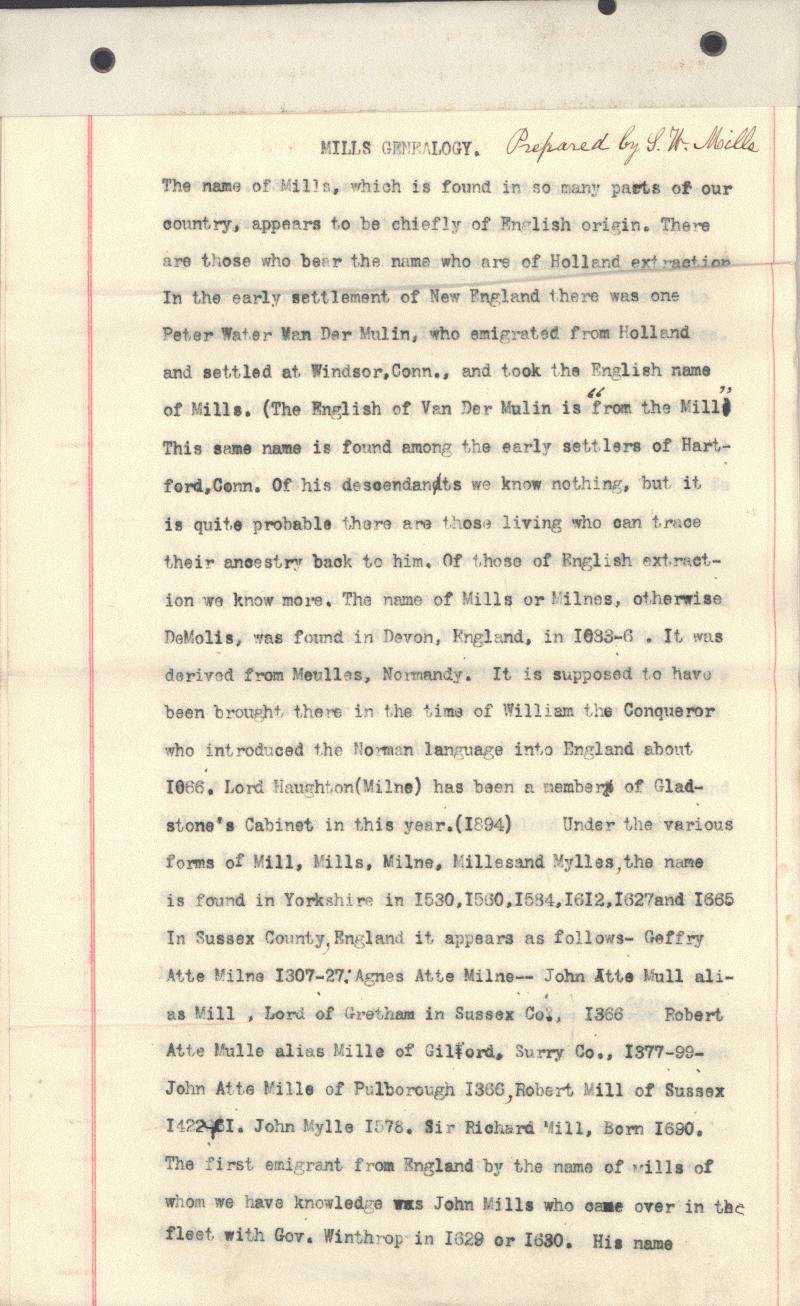
MILLS GENEALOGY.
Prepared by S. W. Mills
The name of Mills, which is found in so many parts of our country, appears to be chiefly of English origin. There are those who bear the name who are of Holland extraction. In the early settlement of New England there was one Peter Water Van Der Mulin, who emigrated from Holland and settled at Windsor, Conn., and took the English name of Mills. (The English of Van Der Mulin is “from the Mill”.) This same name is found among the early settlers of Hartford, Conn. Of his descendants we know nothing, but it is quite probable there are those living who can trace their ancestry back to him. Of those of English extraction we know more. The name of Mills or Milnes, otherwise DeMolis, was found in Devon, England, in 1083-6. It was derived from Meulles, Normandy. It is supposed to have been brought there in the time of William the Conqueror who introduced the Norman language into England about 1066. Lord Haughton (Milne) has been a member of Gladstone’s Cabinet in this year. (1894) Under the various forms of Mill, Mills, Milne, Milles and Mylles, the name is found in Yorkshire in 1530, 1560, 1584, 1612, 1627 and 1665. In Sussex County, England it appears as follows- Geffry Atte Milne 1307-27: Agnes Atte Milne– John Atte Mull alias Mill, Lord of Grethan in Sussex Co., 1366 Robert Atte Mulle alias Mille of Gilford, Surry Co., 1377-99- John Atte Mille of Pulborough 1366, Robert Mill of Sussex 1422-61. John Myllle 1578. Sir Richard Mill, Born 1690. The first emigrant from England by the name of Mills of whom we have knowledge was John Mills who came over in the fleet with Gov. Winthrop in 1629 or 1630. His name
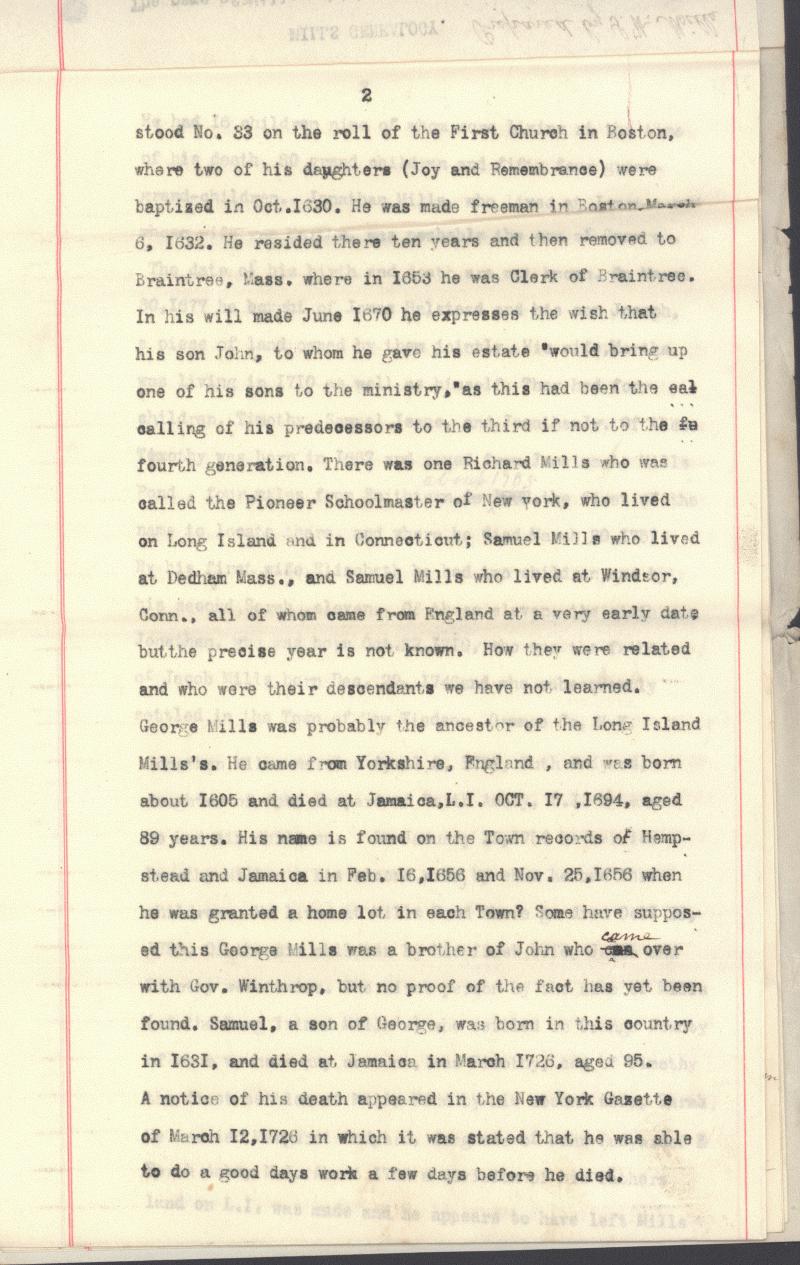
2
stood No. 33 on the roll of the First Church in Boston, where two of his daughters (Joy and Remembrance) were baptized in Oct. 1630. He was made freeman in Boston, March 6, 1632. He resided there ten years and then removed to Braintree, Mass. where in 1653 he was Clerk of Braintree. In his will made June 1670 he expresses the wish that his son John, to whom he gave his estate ‘would bring up one of his sons to the ministry,’ as this had been the calling of his predecessors to the third if not to the fourth generation. There was one Richard Mills who was called the Pioneer Schoolmaster of New York, who lived on Long Island and in Connecticut; Samuel Mills who lived in Dedham Mass., and Samuel Mills who lived at Windsor, Conn., all of whom came from England at a very early date but the precise year is not known. How they were related and who were their descendants we have not learned.
George Mills was probably the ancestor of the Long Island Mills’s. He came from Yorkshire, England and was born about 1605 and died at Jamaica, L.I. OCT. 17, 1694, aged 89 years. His name is found on the Town records of Hempstead and Jamaica in Feb. 16, 1656 and Nov. 25, 1656 when he was granted a home lot in each Town? Some have supposed this George Mills was a brother of John who came over with Gov. Winthrop, but no proof of the fact has yet been found. Samuel, a son of George, was born in this country in 1631, and died at Jamaica in March 1726, aged 95. A notice of his death appeared in the New York Gazette of March 12, 1726, in which it was stated that he was able to do a good days work a few days before he died.
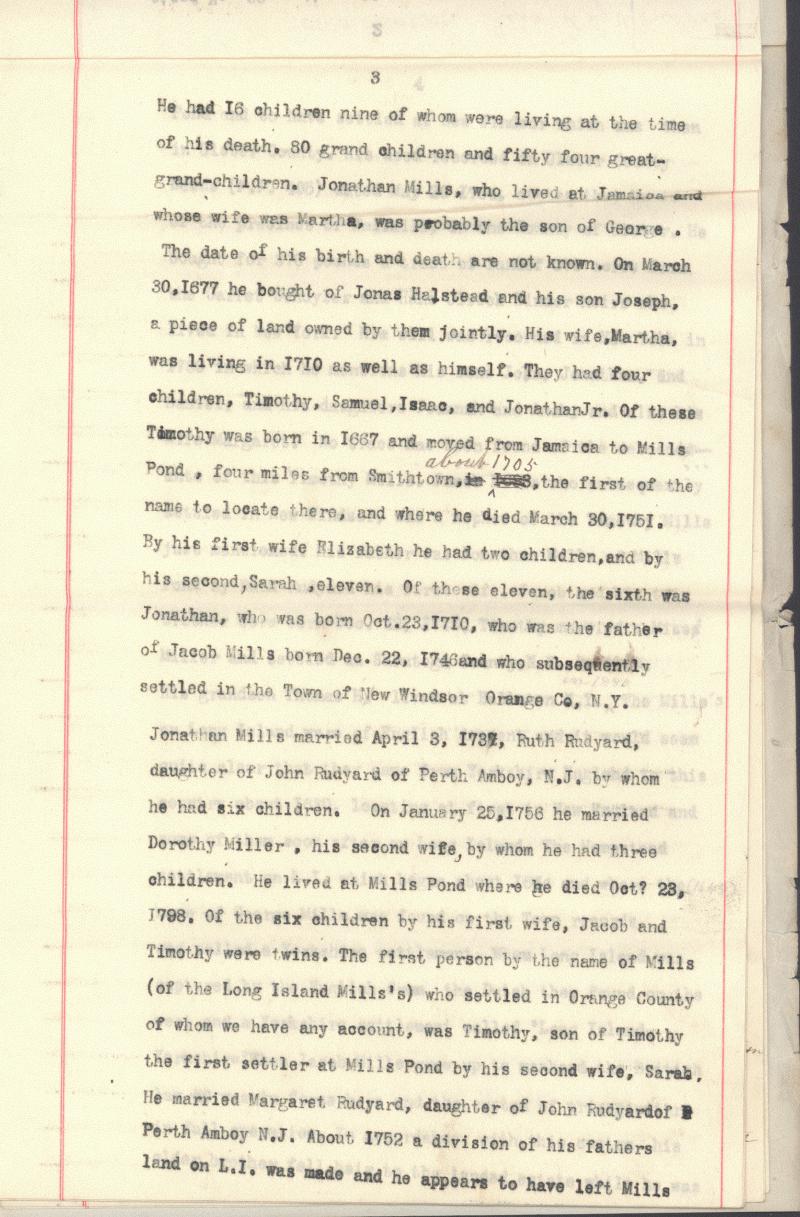
3
He had 16 children nine of whom were living at the time of his death, 80 grand children and fifty four great-grand-children. Jonathan Mills, who lived at Jamaica and whose wife was Martha, was probably a son of George.
The date of his birth and death are not known. On March 30, 1677, he bought of Jonas Halstead and his son Joseph, a piece of land owned by them jointly. His wife, Martha, was living in 1710 as well as himself. They had four children, Timothy, Samuel, Isaac and Jonathan Jr. Of these Timothy was born in 1667 and moved from Jamaica to Mills Pond, four miles from Smithtown about 1705, the first of the name to locate there, and where he died March 30, 1751. By his first wife Elizabeth he had two children, and by his second, Sarah, eleven. Of these eleven, the sixth was Jonathan, who was born Oct. 23, 1710, who was the father of Jacob Mills born Dec. 22, 1746 and who subsequently settled in the Town of New Windsor Orange Co, N.Y.
Jonathon Mills married April 3, 1737, Ruth Rudyard, daughter of John Rudyard of Perth Amboy, N.J. by whom he had six children. On January 25, 1756 he married Dorothy Miller, his second wife, by whom he had three children. He lived at Mills Pond where he died Oct? 23, 1798. Of the six children by his first wife, Jacob and Timothy were twins. The first person by the name of Mills (of the Long Island Mills’s) who settled in Orange County of whom we have any account, was Timothy, son of Timothy the first settler at Mills Pond by his second wife, Sarah. He married Margaret Rudyard, daughter of John Rudyard of Perth Amboy N.J. About 1752 a division of his fathers land on L.I. was made and he appears to have left Mills
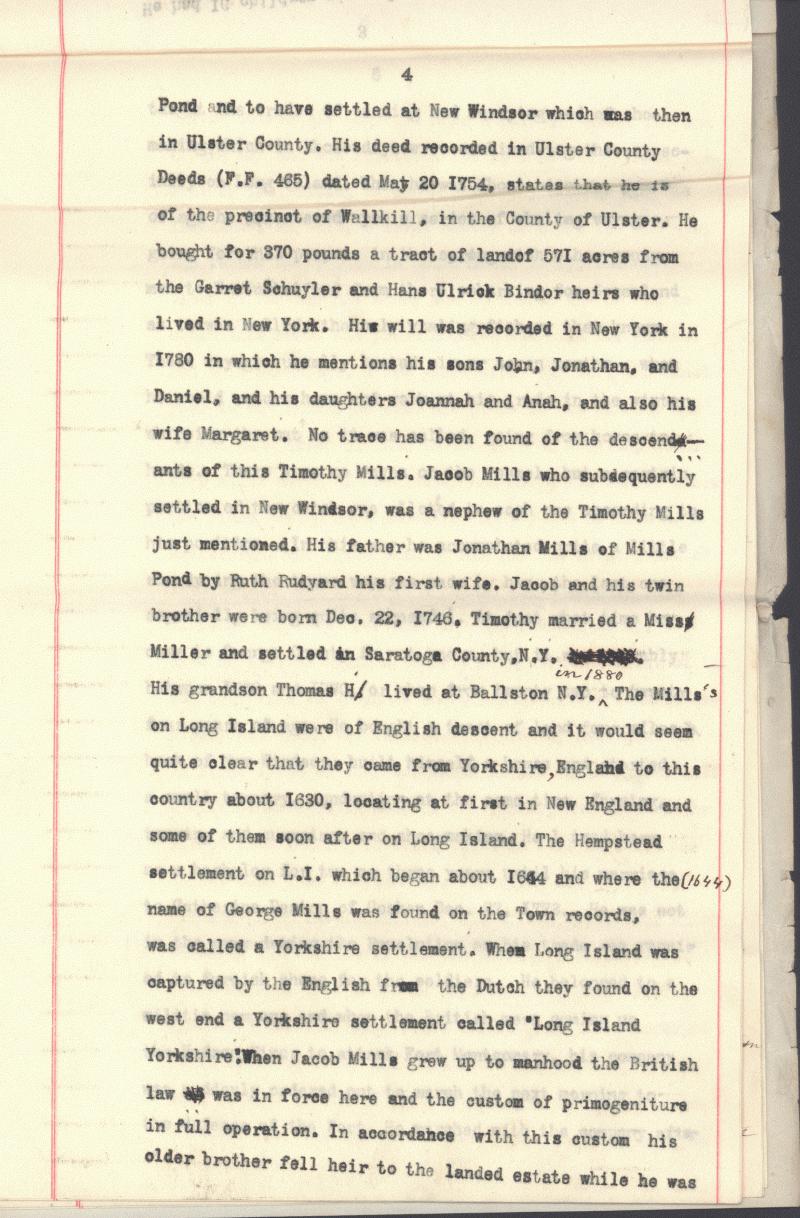
4
Pond and to have settled at New Windsor which was then in Ulster County. His deed recorded in Ulster County Deeds (F.F. 465) dated May 20, 1754, states that he is of the precinct of Wallkill, in the County of Ulster. He bought for 370 pounds a tract of land of 571 acres from the Garret Schuyler and Hans Ulrick Bindor heirs who lived in New York. His will was recorded in New York in 1780 in which he mentions his sons John, Jonathan, and Daniel, and his daughters Joannah and Anah, and also his wife Margaret. No trace has been found of the descendants of this Timothy Mills. Jacob Mills who subsequently settled in New Windsor, was a nephew of the Timothy Mills just mentioned. His father was Jonathan Mills of Mills Pond by Ruth Rudyard his first wife. Jacob and his twin brother were born Dec. 22, 1746. Timothy married a Miss Miller and settled in Saratoga County, N.Y. His grandson Thomas H. lived at Ballston N.Y. in 1880. The Mills’s on Long Island were of English descent and it would seem quite clear that they came from Yorkshire, England, to this country about 1630, locating at first in New England and some of them soon after on Long Island. The Hempstead settlement on L.I. which began about 1644 and where the (1644) name of George Mills was found on the Town records, was called a Yorkshire settlement. When Long Island was captured by the English from the Dutch they found on the west end a Yorkshire settlement called “Long Island Yorkshire.” When Jacob Mills grew up to manhood the British law was in force here and the custom of primogeniture in full operation. In accordance with this custom his older brother fell heir to the landed estate while he was
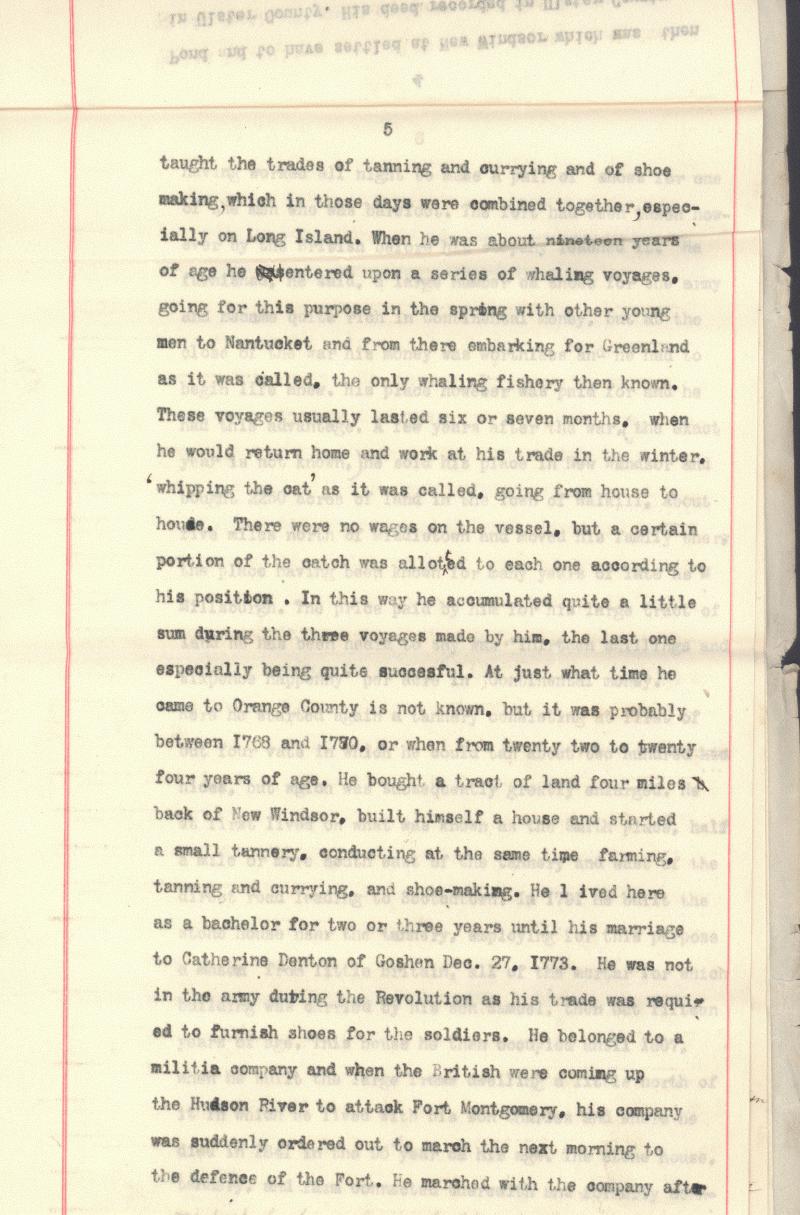
5
taught the trades of tanning and currying and of shoe making, which in those days were combined together, especially on Long Island. When he was about nineteen years of age he entered upon a series of whaling voyagers, going for this purpose in the spring with other young men to Nantucket and from there embarking for Greenland as it was called, the only whaling fishery then known. These voyages usually lasted six or seven months, when he would return home and work at his trade in the winter, ‘whipping the cat’ as it was called, going from house to house. There were no wages on the vessel, but a certain portion of the catch was allotted to each one according to his position. In this way he accumulated quite a little sum during the three voyages made by him, the last one especially being quite successful. At just what time he came to Orange County is not known, but it was probably between 1768 and 1770, or when from twenty two to twenty four years of age. He bought a tract of land four miles back of New Windsor, built himself a house and started a small tannery, conducting at the same time farming, tanning and currying, and shoe-making. He lived here as a bachelor for two or three years until his marriage to Catherine Denton of Goshen Dec. 27, 1773. He was not in the army during the Revolution as his trade was required to furnish shoes for the soldiers. He belonged to a militia company and when the British were coming up the Hudson River to attack Fort Montgomery, his company was suddenly ordered out to march the next morning to the defense of the Fort. He marched with the company after
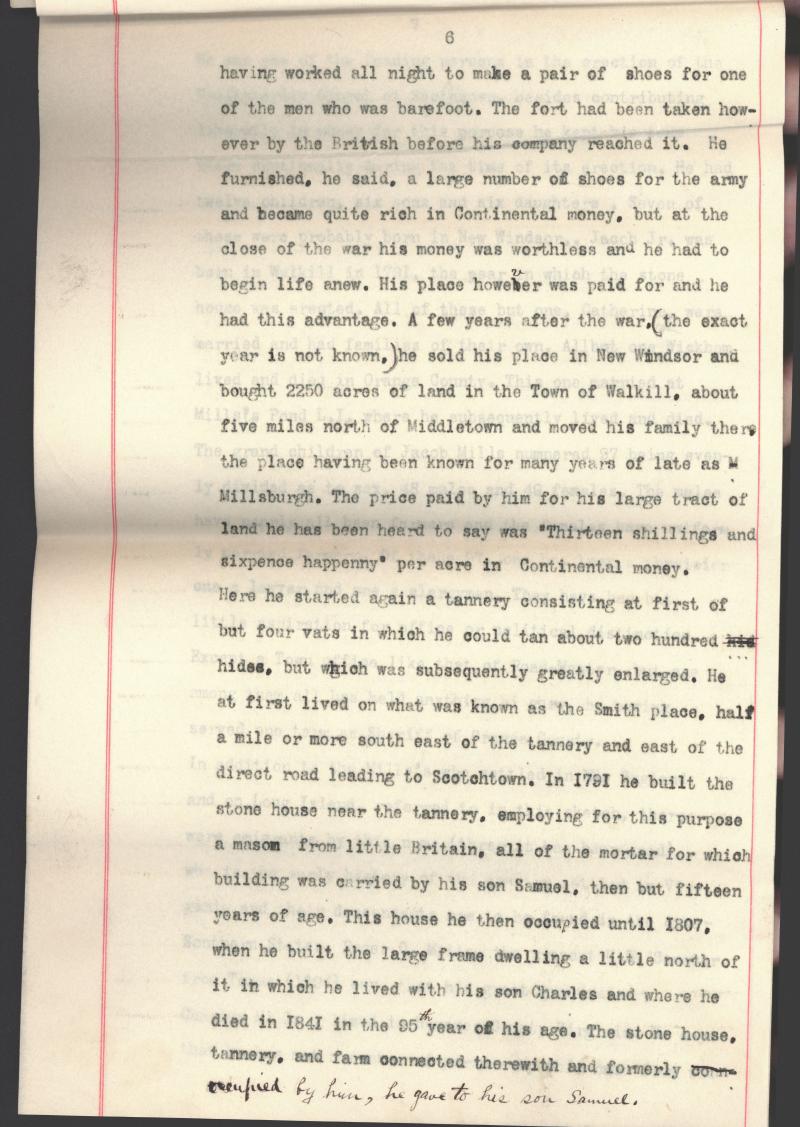
6
having worked all night to make a pair of shoes for one of the men who was barefoot. The fort had been taken however by the British before his company reached it. He furnished, he said, a large number of shoes for the army and became quite rich in Continental money, but at the close of the war his money was worthless and he had to begin life anew. His place however was paid for and he had this advantage. A few years after the war, (the exact year is not known,) he sold his place in New Windsor and bought 2250 acres of land in the Town of Walkill, about five miles north of Middletown and moved his family there, the place having been known for many years of late as Millsburgh. The price paid by him for his large tract of land he has been heard to say was “Thirteen shillings and sixpence happenny” per acre in Continental money.
Here he started again a tannery consisting at first of but four vats in which he could tan about two hundred hides, but which was subsequently greatly enlarged. He at first lived on what was known at the Smith place, half a mile or more south east of the tannery and east of the direct road leading to Scotchtown. In 1791 be built the stone house near the tannery, employing for this purpose a mason from little Britain, all of the mortar for which building was carried by his son Samuel, then but fifteen years of age. This house he then occupied until 1807, when he built the large frame dwelling a little north of it in which he lived with his son Charles and where he died in 1841 in the 95th year of his age. The stone house, tannery, and farm connected therewith and formerly occupied by him, he gave to his son Samuel.
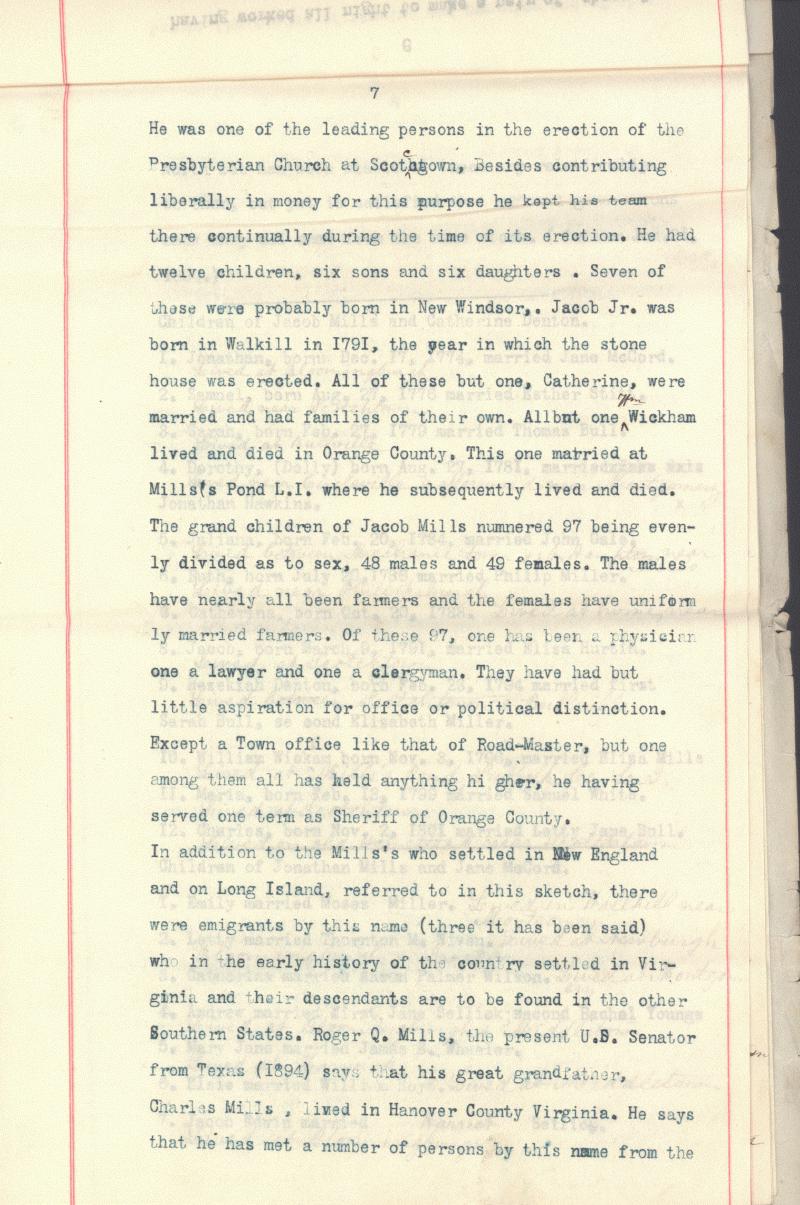
7
He was one of the leading persons in the erection of the Presbyterian Church at Scotchtown. Besides contributing liberally in money for this purpose he kept his team there continually during the time of its erection. He had twelve children, six sons and six daughters. Seven of these were probably born in New Windsor. Jacob Jr. was born in Walkill in 1791, the year in which the stone house was erected. All of these but one, Catherine, were married and had families of their own. All but one, Wm. Wickham lived and died in Orange County. This one married at Mills’s Pond L.I. where he subsequently lived and died. The grand children of Jacob Mills numbered 97 being evenly divided as to sex, 48 males and 49 females. The males have nearly all been farmers and the females have uniformly married farmers. Of these 97, one has been a physician one a lawyer and one a clergyman. They have had but little aspiration for office or political distinction. Except a Town office like that of Road-Master, but one among them all has held anything higher, having served one term as Sheriff of Orange County.
In addition to the Mills’s who settled in New England and on Long Island, referred to in this sketch, there were emigrants by this name (three it has been said) who in the early history of the country settled in Virginia and their descendants are to be found in other Southern States. Roger Q. Mills, the present U.S. Senator from Texas (1894) says that his great grandfather, Charles Mills, lived in Hanover County Virginia. He says that he has met a number of persons by this name from the
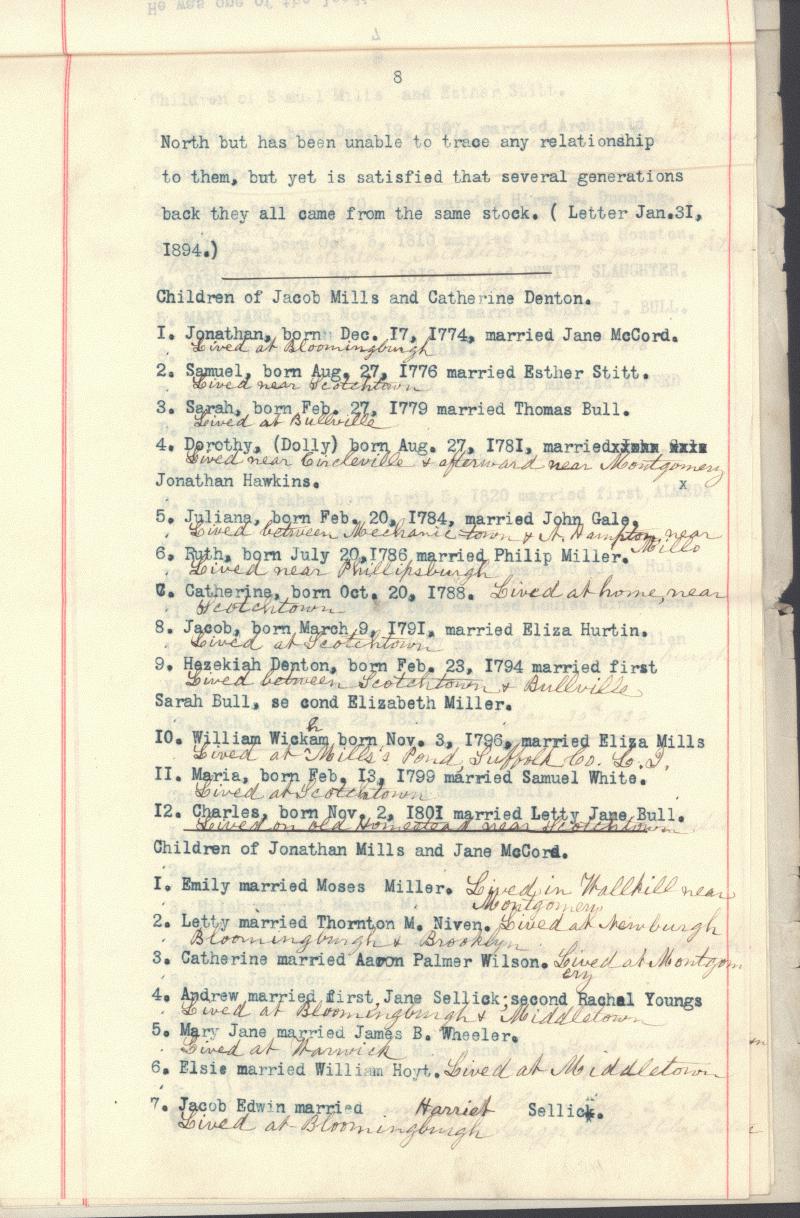
8
North but has been unable to trace any relationship to them, but yet is satisfied that several generations back they all came from the same stock. (Letter Jan. 31, 1894.)
Children of Jacob Mills and Catherine Denton.
Jonathon, born Dec. 17, 1774, married Jane McCord. Lived at Bloomingburgh.
Samuel, born Aug. 27, 1776 married Esther Stitt. Lived near Scotchtown.
Sarah, born Feb. 27, 1779 married Thomas Bull. Lived at Bullville.
Dorothy, (Dolly) born Aug. 27, 1781, married Jonathan Hawkins. Lived near Circleville and afterward near Montgomery.
Juliana, born Feb. 20, 1784, married John Gale. Lived between Mechanicstown and N. Hampton near Mills.
Ruth, born July 20, 1786, married Philip Miller. Lived near Phillipsburgh.
Catherine, born Oct. 20, 1788. Lived at home, near Scotchtown.
Jacob, born March 9, 1791, married Eliza Hurtin. Lived at Scotchtown.
Hezekiah Denton, born Feb. 23, 1794 married first Sarah Bull, second Elizabeth Miller. Lived between Scotchtown and Bullville.
William Wickham, born Nov. 3, 1796, married Eliza Mills. Lived at Mills’s Pond, Suffolk Co. L.I.
Maria, born Feb. 13, 1799 married Samuel White. Lived at Scotchtown.
Charles, born Nov. 2, 1801 married Letty Jane Bull. Lived on old homestead near Scotchtown.
Children of Jonathan Mills and Jane McCord.
Emily married Moses Miller. Lived in Wallkill near Montgomery.
Letty married Thornton M. Niven. Lived at Newburgh Bloomingburgh and Brooklyn.
Catherine married Aaron Palmer Wilson. Lived at Montgomery.
Andrew married first Jane Sellick; second Rachel Youngs. Lived at Bloomingburgh and Middletown.
Mary Jane married James B. Wheeler. Lived at Warwick.
Elsie married William Hoyt. Lived at Middletown.
Jacob Edwin married Harriet Sellick. Lived at Bloomingburgh.
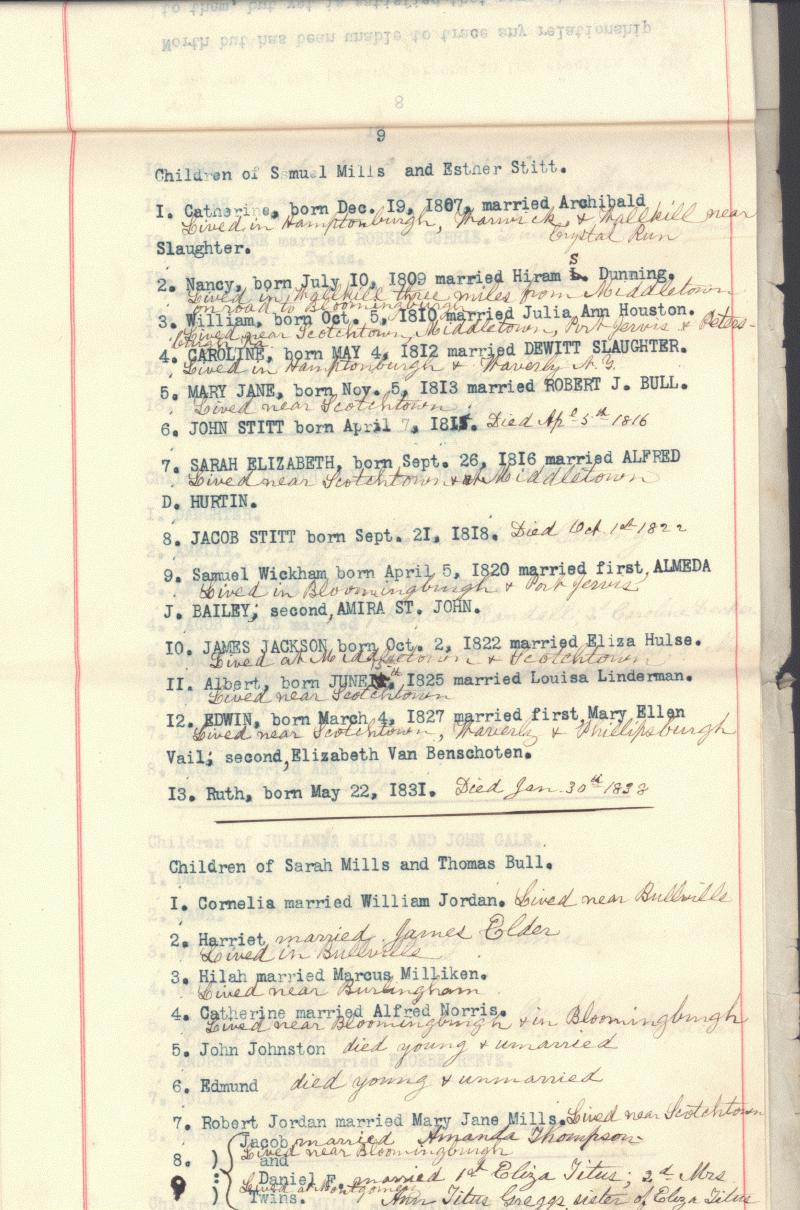
9
Children of Samuel Mills and Esther Stitt.
Catherine, born Dec. 19, 1807, married Archibald Slaughter. Lived in Hamptonburgh, Warwick and Wallkill near Crystal Run.
Nancy, born July 10, 1809 married Hiram S. Dunning. Lived in Wallkill three miles from Middletown on road to Bloomingburgh.
William, born Oct. 5, 1810 married Julia Ann Houston. Lived near Scotchtown, Middletown, Port Jervis and Petersburgh Va.
CAROLINE, born MAY 4, 1812 married DEWITT SLAUGHTER. Lived in Hamptonburgh and Waverly N.Y.
MARY JANE, born Nov. 5, 1813 married ROBERT J. BULL. Lived near Scotchtown.
JOHN STITT born April 7, 1815. Died April 5th 1816.
SARAH ELIZABETH, born Sept. 26, 1816 married ALFRED D. HURTIN. Lived near Scotchtown and [at?] Middletown.
JACOB STITT born Sept. 21, 1818. Died Oct. 1st 1822.
Samuel Wickham born April 5, 1820 married first, ALMEDA J. BAILEY; second AMIRA ST. JOHN. Lived in Bloomingburgh and Port Jervis.
JAMES JACKSON born Oct. 2, 1822 married Eliza Hulse. Lived at Middletown and Scotchtown.
Albert, born JUNE 15th 1825 married Louisa Linderman. Lived near Scotchtown.
EDWIN, born March 4, 1827 married first, Mary Ellen Vail; second, Elizabeth Van Benschoten. Lived near Scotchtown, Waverly and Phillipsburgh.
Ruth, born May 22, 1831. Died Jan. 30th 1838.
Children of Sarah Mills and Thomas Bull.
Cornelia married William Jordan. Lived near Bullville.
Harriet married James Elder. Lived in Bullville.
Hilah married Marcus Milliken. Lived near Burlingham.
Catherine married Alfred Norris. Lived near Bloomingburgh and in Bloomingburgh.
John Johnston died young and unmarried.
Edmund died young and unmarried.
Robert Jordan married Mary Jane Mills. Lived near Scotchtown.
Jacob married Amanda Thompson. Lived near Bloomingburgh.
Daniel F. Married first, Eliza Titus; second, Mrs. Ann Titus Greggs, sister of Eliza Titus. Lived at Montgomery.
(Jacob, 8 and Daniel F., 9 are twins.)
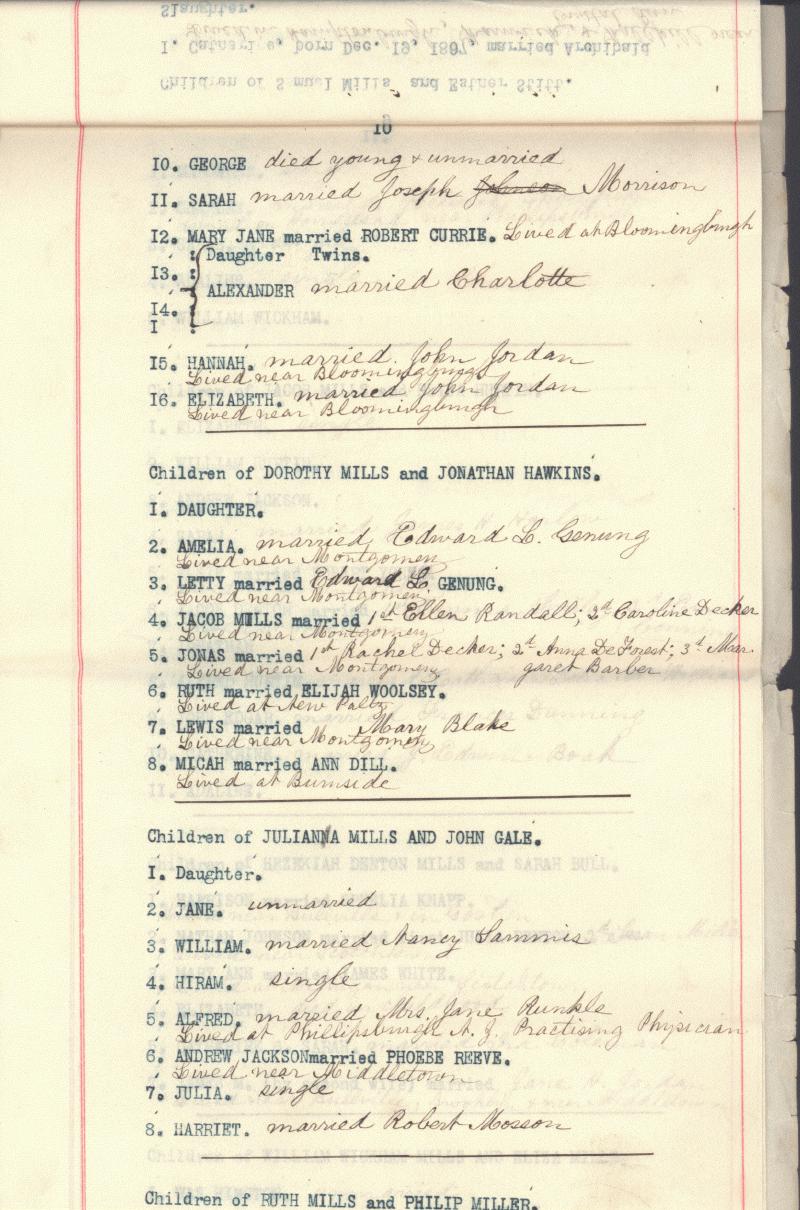
10
GEORGE died young and unmarried.
SARAH married Joseph Morrison.
MARY JANE married ROBERT CURRIE. Lived at Bloomingburgh.
Daughter
ALEXANDER married Charlotte.
(Daughter, 13 and ALEXANDER, 14 are twins.)
HANNAH married John Jordan. Lived near Bloomingsburgh.
ELIZABETH married John Jordan. Lived near Bloomingburgh.
Children of DOROTHY MILLS and JONATHAN HAWKINS.
DAUGHTER.
AMELIA. Married Edward L. Genung. Lived near Montgomery.
LETTY married Edward L. GENUNG. Lived near Montgomery.
JACOB MILLS married first, Ellen Randall; second, Caroline Decker. Lived near Montgomery.
JONAS married first, Rachel Decker; second, Anna DeForest; third, Margaret Barber. Lived near Montgomery.
RUTH married ELIJAH WOOLSEY. Lived at New Paltz.
LEWIS married Mary Blake. Lived near Montgomery.
MICAH married ANN DILL. Lived at Burnside.
Children of JULIANA MILLS and JOHN GALE.
Daughter.
JANE. Unmarried.
WILLIAM. Married Nancy Sammis.
HIRAM. Single.
ALFRED. Married Mrs. Jane Runkle. Lived at Phillipsburgh N. J. Practising physician.
ANDREW JACKSON married PHOEBE REEVE. Lived near Middletown.
JULIA. Single.
Harriet. Married Robert Mosson.
Children of RUTH MILLS and PHILIP MILLER.
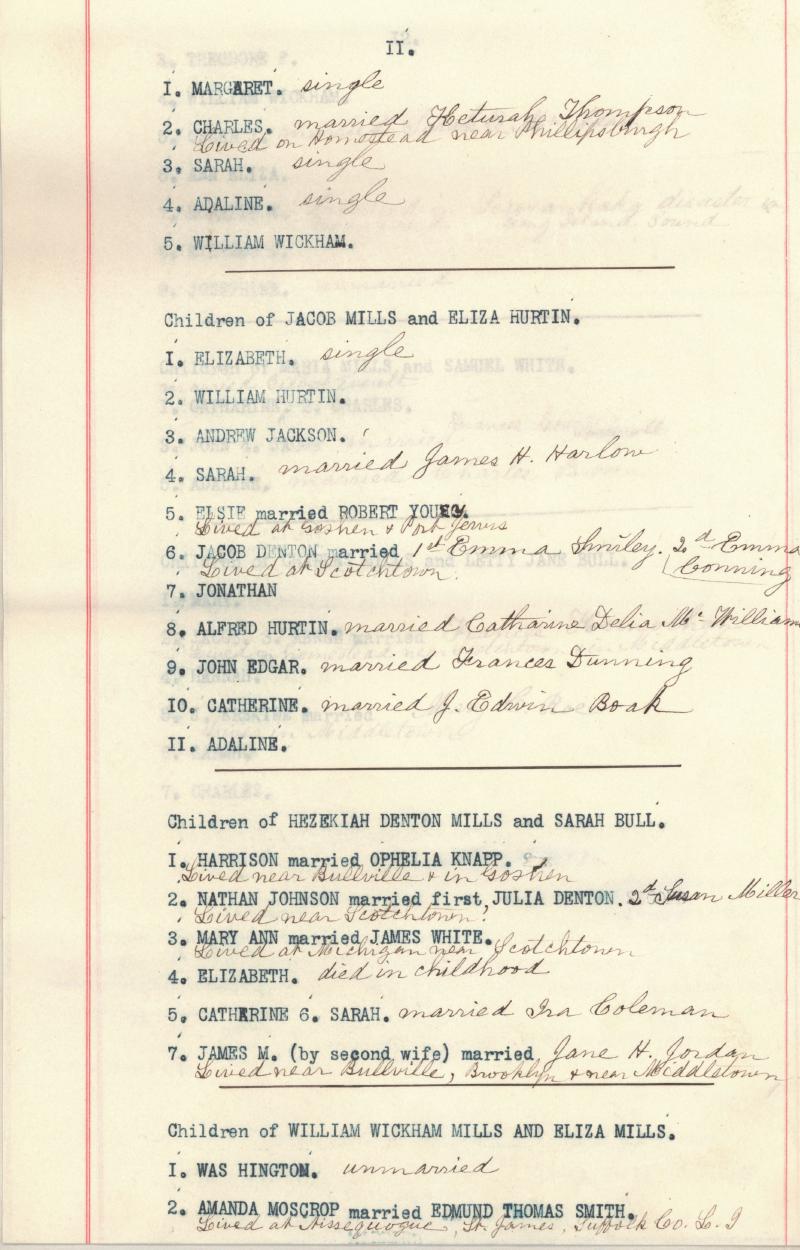
MARGARET. Single.
CHARLES. Married Heturah Thompson. Lived on homestead near Phillipsburgh.
SARAH. Single.
ADALINE. Single.
WILLIAM WICKHAM.
Children of JACOB MILLS and ELIZA HURTIN.
ELIZABETH. Single.
WILLIAM HURTIN.
ANDREW JACKSON.
SARAH. Married James H. Harlow.
ELSIE married ROBERT YOUNG. Lived at Goshen and Port Jervis.
JACOB DENTON married first, Emma Smiley. Second, Emma Conning. Lived at Scotchtown.
JONATHAN.
ALFRED HURTIN. Married Catharine Delia McWilliams.
JOHN EDGAR. Married Frances Dunning.
CATHERINE. Married J. Edwin Boak.
ADALINE.
Children of HEZEKIAH DENTON MILLS and SARAH BULL.
HARRISON married OPHELIA KNAPP. Lived near Bullville and in Goshen.
NATHAN JOHNSON married first, JULIA DENTON. Second, Susan Miller. Lived near Scotchtown.
MARY ANN married JAMES WHITE. Lived at Michigan near Scotchtown.
ELIZABETH. Died in childhood.
CATHERINE 6. SARAH. Married Ira Coleman.
JAMES M. (by second wife) married Jane H. Jordan. Lived near Bullville, Brooklyn and near Middletown.
Children of WILLIAM WICKHAM MILLS AND ELIZA MILLS.
WASHINGTON. Unmarried.
AMANDA MOSCROP married EDMUND THOMAS SMITH. Lived at Nissequogue, St. James, Suffolk Co. L.I.
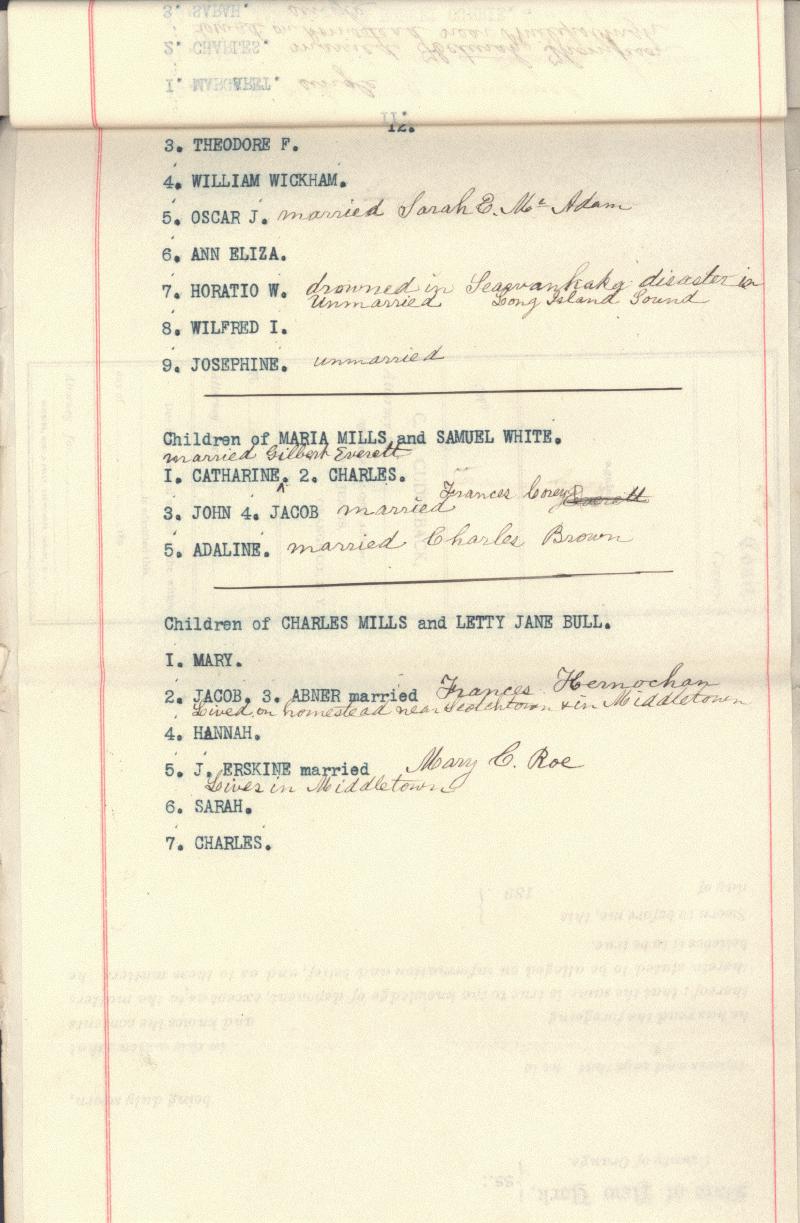
THEODORE F.
WILLIAM WICKHAM.
OSCAR J. Married Sarah E. McAdam.
ANN ELIZA.
HORATIO W. Unmarried. Drowned in Seawanhaka disaster in Long Island Sound. Unmarried.
WILFRED I.
JOSEPHINE. Unmarried.
Children of MARIA MILLS and SAMUEL WHITE.
CATHARINE married Gilbert Everett. 2. CHARLES.
JOHN 4. JACOB married Frances Corey.
ADALINE. Married Charles Brown.
Children of CHARLES MILLS and LETTY JANE BULL.
MARY.
JACOB. 3. ABNER married Frances Hernochan. Lived on homestead near Scotchtown and in Middletown.
HANNAH.
J. ERSKINE married Mary C. Roe. Lives in Middletown.
SARAH.
CHARLES.
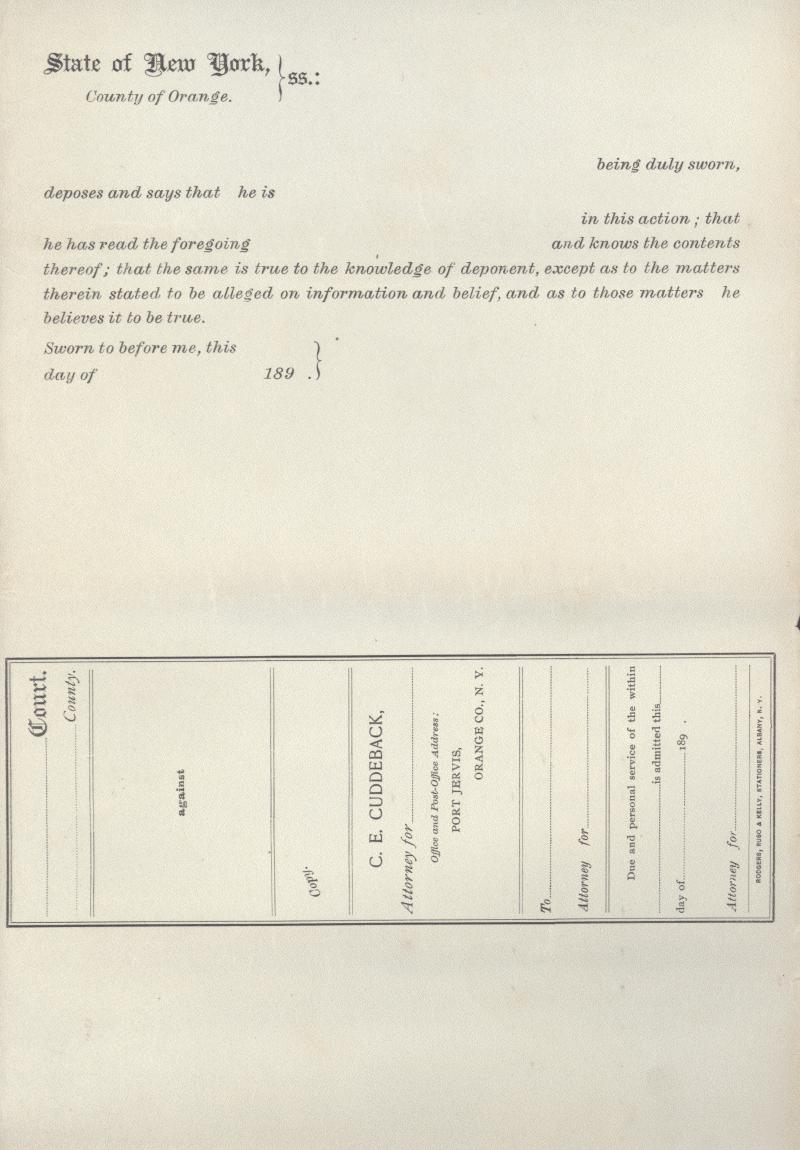
The Seawanhaka Disaster
As Reverend Mills notes in Mills Genealogy above, his cousin Horatio W. Mills (21 Oct 1837 to 28 Jun 1880), son of William Wickham Mills (03 Sep 1797 to 06 Jan 1865) of Mills Pond, “drowned in Seawanhaka disaster in Long Island Sound” on his way to Mills Pond.
On June 28, 1880, a boiler aboard the steamboat Seawanhaka exploded while the boat was in the East River near Wards Island, New York City, setting the boat on fire and resulting in the deaths of 24 to 35 people. A coroner's jury found that although the boiler had passed inspection the prior March and should have been in good working condition, the loss of life was exacerbated by the poor discipline of the boat crew following the explosion.
The name ‘Seawanhaka’ is derived from a tribe of Indians who made their home on Centre Island.
Prior to colonization by European settlers more than 300 years ago, Long Island was home to thirteen Native American tribes. Long Island was initially known as “Sewanhacky,” the name signifying the abundance of quahog, or hard clam, on the island, which the tribes used to make “wampum,” that they used as money.
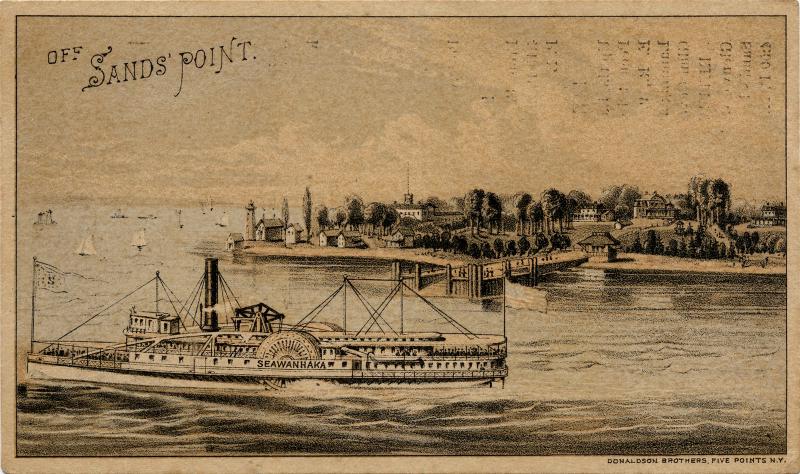
— Image taken from: 03 May 2011, The Seawanhaka Saga Continues, Local History Notes from the Great Neck Library. View largest available size.
The Seawanhaka was one of many steamships that shuttled commuters and daytrippers to and from Manhattan, Whitestone, Great Neck, Sand's Point, Glen Cove, Sea Cliff, Glenwood, and Roslyn. In the days before highways, affordable autos, and commuter railroads like the LIRR, steamships were a major way for people to travel longer distances.
The waterways of New York City and its surrounding areas were full of steamships, which were full of passengers and cargo. These waterways became increasingly dangerous, as more and more steamships and other boats competed for limited shipping lanes and rights of way. Many serious steamship catastrophes, and many more small accidents and near misses, occurred in and around the waters of New York City.
In the late afternoon of June 28, 1880, the steamship Seawanhaka was making its regular trip up the East River from its last Manhattan boarding dock to Long Island, with many commuters aboard. As the ship sailed into the narrows between Hell Gate and Little Hell Gate, her boiler caught fire. Flames quickly spread to the ship’s other decks. With no docks in sight, and heavy boat traffic on both sides, Captain Charles P. Smith piloted his ship to the wetland shore of Randall’s Island. He ran the Seawanhaka aground in a spot called the sunken meadow. Half the ship sat on marshland; the other half faced the waters of the East River. Captain Smith stayed with his ship until he blacked out. He had been badly burned on the face and hands while steering his ship to the best landing site available.
Those fleeing the Seawanhaka were forced to choose between a blazing, sinking ship, swampy marshland, and inhospitable waters - many could not swim. Over forty people perished in the Seawanhaka fire, drowned fleeing the ship, or died from injuries suffered in the disaster, including several Great Neck residents.
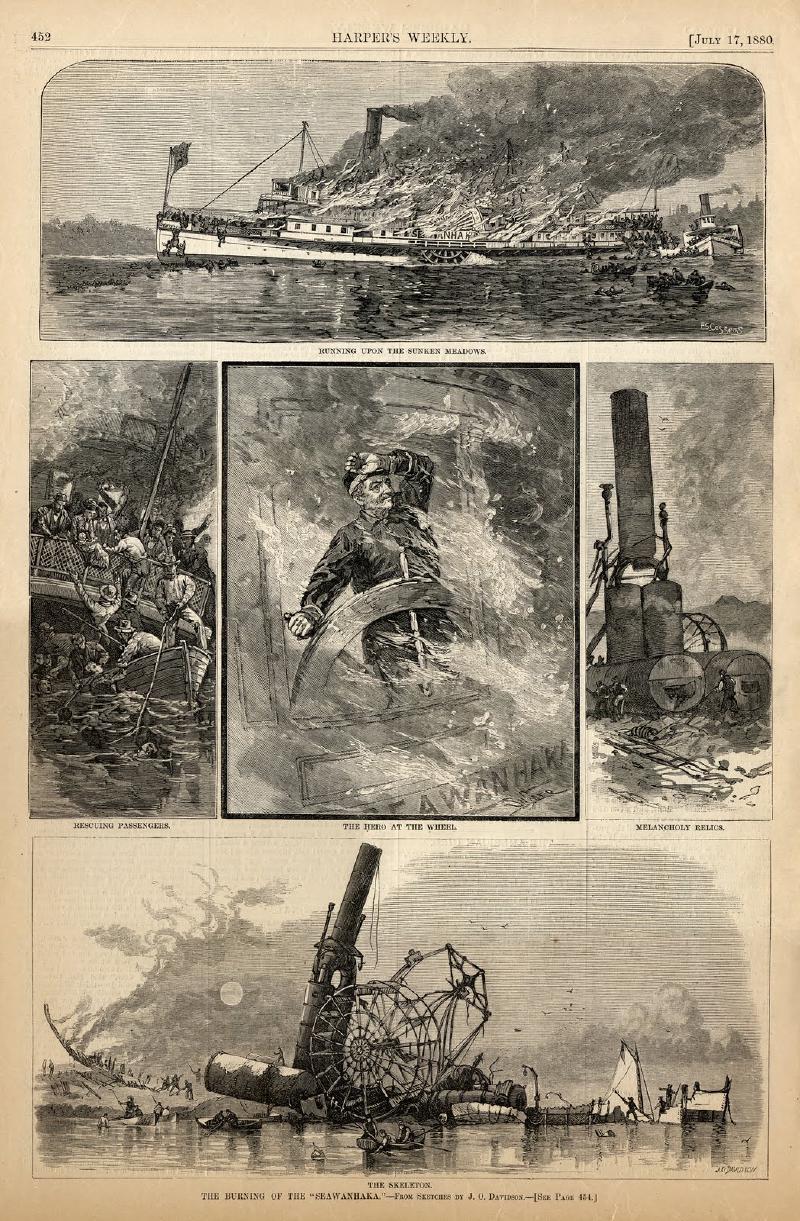
— 17 Jul 1880, Harper’s Weekly, p452. Image taken from: 03 May 2011, The Seawanhaka Saga Continues, Local History Notes from the Great Neck Library. View largest available size.
On the entire front page of the 29 Jun 1880 edition of The New York Times, only news of the Seawanhaka disaster was reported. The event and its aftermath were reported statewide for many months, including in newspapers in Tompkins, Erie, and Orange counties.
Initially nobody knew that Horatio Mills was a passenger on the boat, and his remains may not have been identified except for papers he was carrying when he died. (And even then, those papers would likely have been lost had Horatio’s body been discovered first by the “river thieves”, “human ghouls” who “hunt[ed] the wreck of the Seawanhaka to rob the bodies of the victims”.) Although Horatio was known to be a “very fine swimmer”, a large bruise on his back suggested he was severely injured from striking the boat’s paddle wheel during his attempted escape.
Horatio was a Columbia educated lawyer “endowed with talents of the highest order”.
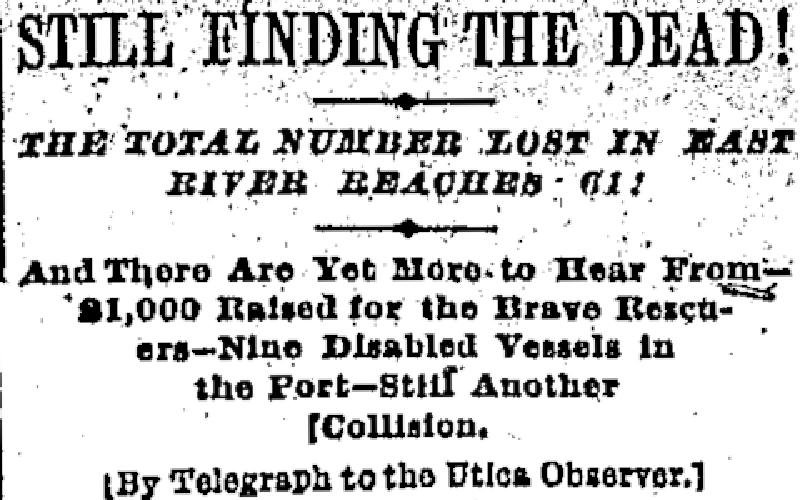
STILL FINDING THE DEAD!
THE TOTAL NUMBER LOST IN EAST RIVER REACHES 61!
And There Are Yet More to Hear From– $1,000 Raised for the Brave Rescuers—Nine Disabled Vessels in the Port—Still Another Collision.
[By Telegraph to the Utica Observer.]
New York, July 1.—Twenty-seven corpses have been recovered from the Seawanhaka, and twenty-five identified. Additional inquiries yesterday at the Morgue swell the list of missing to thirty-two, and two victims remaining on Ward’s Island will not survive. This places the probable total at sixty-one deaths, with possibly more to hear from,
REWARDING MERIT.
The subscriptions for the officers of the Seawanhaka and others who displayed courage during tho recent disaster, has reached nearly $1,000 thus far.
SUCCESSION OF DISABTERS.
Yesterday, nine steam vessels, recently either burned or temporarily disabled by fire or collision, were lying in port.
BURNED TO A CRISP.
Flushing, L. L, July 1.—The body of Edward Westcott, of Manhasset, a victim of tho Seawanhaka disaster, was found on the wreck yesterday afternoon, burned to a crisp. He leaves a wife and four children.
THE BODY OF A BOY.
College Point, July 1.—The body of a boy, aged 10, was found off Stolber’s dock this afternoon, with hair gone from the top of the head, and bruised about the face. It is thought he was a victim of the Seawanhaka disaster.
TWICE FORTUNATE.
Jersey City, N.J., July 1—Mrs. Robert Carpenter, reported as among the missing passengers of the Seawanhaka, arrived home yesterday. She started for the Seawanhaka and arrived on the dock just as the gang plank was being pulled in. She then took the Elevated Road to Thirty-third street to take the steamboat at the next landing, but again arrived in time to see the gang plank pulled in. She went to her destination, Sea Cliff, by rail.
THE DEAD.
New York, July 1.—The following are additional names of tho dead: Lizzie Aikens, age 45, wife of Irwin Aikens, of Sea Cliff; Mary Ann Flynn, aged 30, Second Avenue, a niece of Captain John White, an old Hell Gate pilot; Josiah Hasbrouck, colored, 70, cook of the Seawanhaka; Mrs. Margaret Maloney, 62, Williamsburg; John Rauscher, infant; Katie Rauscher, 3 Ninth Avenue, New York; Mrs. Augusta Rinan, aged 25, servant, Glen Cove; James Skedmore, Jr., aged 23, lawyer, Pearl street, New York; Clarence W. Vandewater, aged 60, an old resident of Whitestone.
STILL ANOTHER COLLISION.
The steamboat J. V. Wilson, running to Coney Island, collided with the steamboat Plymouth Rook at the foot of Twenty-second street yesterday. The Wilson was badly damaged, and there was great excitement among the passengers.
— 01 Jul 1880, Utica Daily Observer, Utica NY, p3, nyshistoricnewspapers.org. View largest available size.
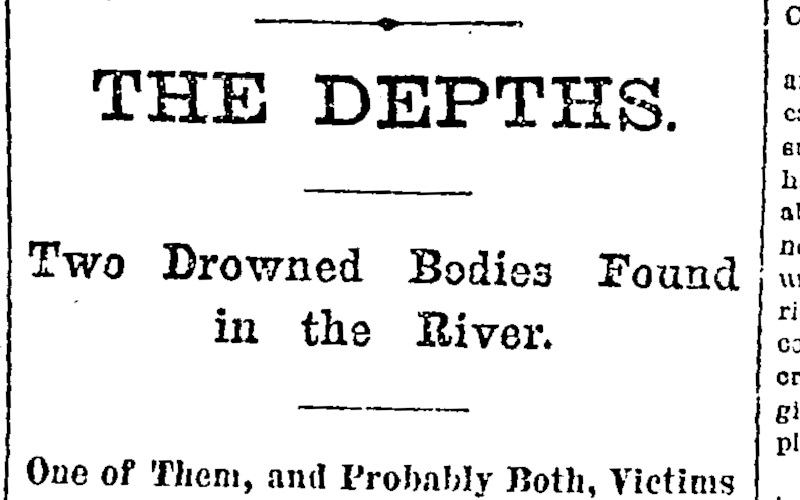
THE DEPTHS.
Two Drowned Bodies Found in the River.
One of Them, and Probably Both, Victims of the Seawanhaka Disaster—Clues to their Identification.
The body of a drowned man, who was undoubtedly a victim of the Seawanhaka disaster, was picked up in the river this morning and is now at the Raymond street Morgue, awaiting identification. About half-past five o’clock, A. P. Paterson, night watchman at F. G. Pinto’s stores, Atlantic Dock basin, saw the body floating in with the tide, and procuring a shell boat rowed out and secured it. Dr. Henry C. Simms, the Coroner, subsequently ordered its removal to the Morgue, where it will remain until claimed by relatives or friends. The body is that of a man about 35 years of age; 5 feet 9 inches in height, of stout build, mustache, sandy hair and bald on the top of the head, and was dressed in a gray tweed suit, plaid shirt, white cotton undershirt and congress gaiters. On the small of the back was a severe bruise, as if he had been struck by some heavy substance. If a passenger on the ill fated Seawanhaka, he was probably struck by the wheel. When the body was removed to the Morgue a careful examination of the body and articles on it was made and the following were found: $14 in money, a small silver watch, which ad stopped at four minutes’ past 5 o’clock, just the time when the disaster referred to occurred, a small memorandum book, two business cards of C. J. Thomas, diamond broker, No. 661 Broadway, New York, on the back of one of which was the following memorandum: “30 days, May 29, 1880, Mr. James, gold chain, $10.” There was also a piece of paper on which was written in a bold male hand the following: “Mrs. H. W. Thorpe, Scudin House, Glenwood, L.I., steamer Seawanhaka; Peck Slip 4:15 daily. Steam cars from Hunter’s Point to Glen Head, any hour up to 6:30 P.M.” It would seem from this memorandum that the unfortunate passenger, whoever he was, was going to Glenwood to visit Mrs. Thorpe, and had received directions as to the two routes which he could take to reach Glenwood. There was also a business card of “Martin Klenan, real estate, mortgage and insurance broker, office No. 55 Liberty street, corner of Nassau, and 46 East Twenty-third street, New York, M. C. A. B.” The two memorandum books do not give any clue to identification, with the single exception, that on the fly leaf of one of them is the entry, “Horatio B. Mills, brother of W. J. Mills, 14 West Seventeenth street.” The books are filled with the numbers of houses in New York, the names of the residents no however being given. Appended to some of the numbers is the suggestive word “good.” Superintendent Campbell has communicated all the facts bearing on the case to the New York police authorities, with a view to secure the identification of the body. There is no name among those reported missing which corresponds with any found in these papers and memoranda. The body, however, will probably be identified before evening.
ANOTHER DROWNED BODY
was found this morning in the river outside Roberts’ stores, and was also taken to the Morgue. It i s that of a man about 35 years of age, five feet nine inches in height, with dark hair and side whiskers and mustache. The only clothing on the body was a white cotton outside and a light flannel inside shirt. The right leg was cut off below the knee. This is likewise supposed to be the body of one of the victims of the disaster. The theory is that he was a passenger who went to this state room and undressed as soon as he got on the boat, and that his leg was cut off by the wheel. The body looks as if it had been in the water only three or four days.
The first body is supposed to be that of Horatio W. Mills, of Smithtown, Suffolk County, New York. Post Office address, New York City, 5,911.
In the shirt on the second box there were three pearl studs in shirt front, a pair of sleeve buttons, with letter “S.,” and on the shirt band were the letters “H. A. B.,” which correspond with the initials of one of the missing passengers, named Horace A. Schriener. The blue scarf was held together with a plated wire ring. Superintendent Campbell has communicated with the New York police authorities in reference to this body also.
— 02 Jul 1880, The Brooklyn Daily Eagle, Brooklyn NY, p4, nyshistoricnewspapers.org. View largest available size.
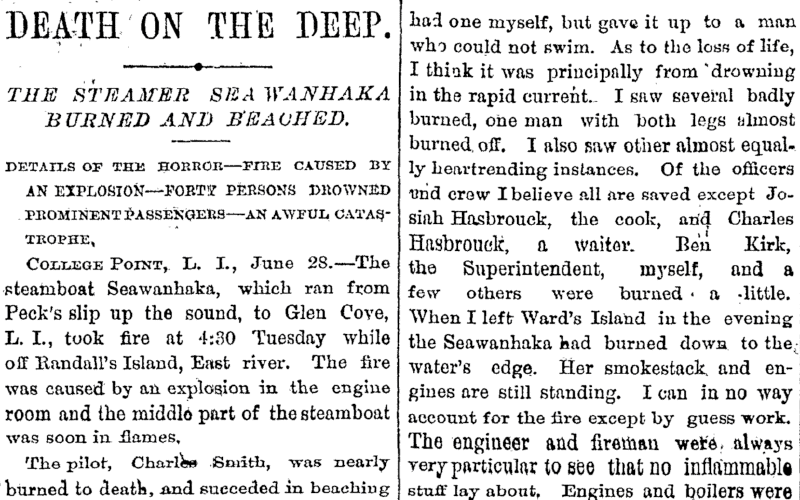
DEATH ON THE DEEP.
THE STREAMER SEAWANHAKA BURNED AND BEACHED.
DETAILS OF THE HORROR—FIRE CAUSED BY AN EXPLOSION—FORTY PERSONS DROWNED PROMINENT PASSENGERS—AN AWFUL CATASTROPHE.
College Point, L. I., June 28.—The steamboat Seawanhaka, which ran from Peck’s slip up the sound, to Glen Coye, L. L, took fire at 4:30 Tuesday while off Randall’s Island, East river. The fire was caused by an explosion in the engine room and the middle part of the steamboat was soon in flames.
The pilot, Charles Smith, was nearly burned to death, and succeeded in beaching the vessel on a sunken meadow adjoining the Island.
Many persons sprang overboard and were drowned. Many others in the stern of the vessel could not get off, and were burned to death. Of 300 supposed to have been on board, 50 are believed to have perished. The bodies of about 30 have been recovered. Only those of Dr. Bebaise, a wealthy gentleman, residence unknown, and Mary Reed, a young woman, were identified.
Among the persons of prominence known to have been on board were Charles A. Dana, editor of the Sun, S. L. M. Barlow, Col. W. R Chase and R. H. Rochester, treasurer of the Western Union Telegraph Company.
CAPT. SMITH’S STATEMENT.
Capt. Charles P. Smith, who commanded the Seawanhaka, lay in a private room in the hospital on Randall’s Island. The Captain is a large and stout man, and naturally of a florid color. But his face last evening, as a result of the burning that it received, was swollen to nearly double its ordinary size, and reddened to angry hue. Oil-soaked bandages covered the greater part of his face, the upper part of his body, and his arms and hands. The Captain appeared not to heed the great pain he must have suffered, and spoke cheerily.
“I can remember,” he said, “only that we were opposite the entrance to Little Hell Gate at about 4:50, when I heard a dull, heavy explosion, and felt a strong, jar under me. I was in the pilot house, at the wheel, with an assistant. Almost as soon as I felt the jar fire burst through the hurricane deck, and spread like a train of gunpowder backward, and forward. The passengers began to run wildly to and fro on the lower decks, and I shouted to them to be quiet, and all would yet be well. But the flames spread, and the passengers became more excited. We were at the point of the Sunken Meadows, nearly opposite Randall’s Island.
I felt that the only place where I could possibly beach the Seawanhaka with surety was the meadows. I turned her head straight as a die for the meadows. I held on to the wheel, and kept calling to the passengers below to get forward, if possible, and stick to the boat. But, though I was directing my whole attention to the meadows, looking out for the longest and marshiest spot, I could see that some of the passengers in their fright, took to the water. The Seawanhaka obeyed her helm to a charm; and swept onward toward the meadows. I picked out the spot where I saw the beach lying lowest, and bore down upon it. The Seawanhaka grated upon the thick undergrowth, and almost leaped upon the beach. She rose out of the water until her paddle-wheels were high and dry. Then the passengers on the bow leaped down into the yielding marsh, and clambered up to dry land. Those at the stern jumped overboard and swam to the beach or were picked up by the small boats that came from the New York shore or Randall’s Island. I do not recollect clearly how I got ashore, but I soon found myself in the kindly hands of the doctors from Randall’s Island.
FIREMAN ABEEL’S STORY,
Edward Abeel, one of the firemen on the Seawanhaka, made the following statement: “The Seawanhaka left Pier 24, N. R., at 4 1/2, her usual hour of sailing. She stopped at 33d street, East River, to take aboard some more passengers, As near as I can guess there must have been somewhere in the neighborhood of 300 passengers on board. I had been working hard all day on deck, and went below to change my clothes, I took a petticoat or little hand lamp with me into the fire room, and placed it on the keelson. After fixing up I went to the amidship gangway and took a seat on the rail to look out and cool myself off. All of a sudden I heard a noise resembling somewhat on explosion, and, looking around saw flames coming up from between the fire room and engine room. In less than 10 minutes the steamer was one mass of flames from stem to stern. I jumped at once, and called the steward, and cried out to the passengers near me to procure life preservers, that the steamer was on fire. The engineer, Edgar Weeks, was talking to another fireman, and he immediately rushed for the upper deck and began raising the valves, so that no explosion could take place. The steamer went on, and cries were heard on all sides: “For God’s sake, beach her!” The Captain was doing all in his power to do so, and ran her the length of the island as fast as possible. The scene was terrible. The boat was now one fiery furnace, and passengers began to drop off and jump off into the water. There was a strong ebb tide running by this time. The Captain ran her into Little Hell Gate, between Ward’s and Randall’s Islands, and beached her well up on Ward’s Island. The stern of the boat was in the steam, and the rest of the passengers jumped overboard, some on the starboard and some on the port side. Some swam to Randall’s Island; some to Ward’s. Many boats had by this time arrived on the scene, and were picking up passengers in all directions. The Granite State was just ahead of us, but afraid to come alongside for fear she would catch fire herself. She, however, lowered boats at once. The Minnahannock and Osseo also came up and tendered much assistance in taking off and picking up passengers, as did two city boats and several rowboats. Many of the passenger I saw with life preservers. I had one myself, but gave it up to a man who could not swim. As to the loss of life, I think it was principally from drowning in the rapid current. I saw several badly burned, one man with both legs almost burned off. I also saw other almost equally heartrending instances. Of the officers and crew I believe all are saved except Josiah Hasbrouck, the cook, and Charles Hasbrouck, a waiter. Ben Kirk, the Superintendent, myself, and a few others were burned a little. When I left Ward’s Island in the evening the Seawanhaka had burned down to the water’s edge. Her smokestack and engines are still standing. I can in no way account for the fire except by guess work. The engineer and fireman were always very particular to see that no inflammable stuff lay about. Engines and boilers were considered in excellent condition. The only way I can account for it is the possibility that a flue blew out, opening the furnace door and scattering the fire a considerable distance around. The slight noise I heard may have been a flue bursting. I am certain the boiler did not burst. I think two-thirds of the passengers must have jumped over before she beached. The whole thing was almost instantaneous, affording no possibility of ascertaining with certainty the cause of the fire or even of doing anything to check it.
THE LOST.
There are twenty-four persons drowned and burned whose bodies were recovered [du?] to mid-night Monday and it is thought that about thirty more are yet to be accounted for.
— 02 Jul 1880, Tri-states Union, Port Jervis NY, p1, nyshistoricnewspapers.org. View largest available size.
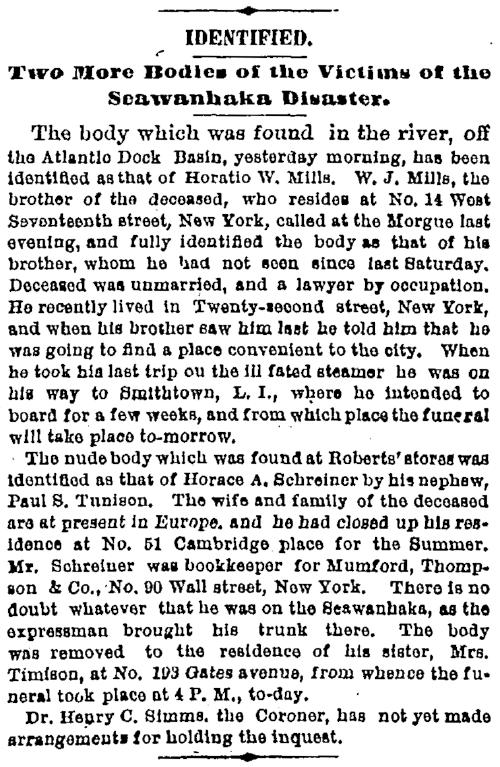
Two More Bodies of the Victims of the Seawanhaka Disaster.
The body which was found in the river, off the Atlantic Dock Basin, yesterday morning, has been identified as that of Horatio W. Mills. W. J. Mills, the brother of the deceased, who resides at No, 14 West Seventeenth street, New York, called at the Morgue last evening, and fully identified the body as that of his brother, whom he had not seen since last Saturday. Deceased was unmarried, and a lawyer by occupation. He recently lived in Twenty-second street, New York, and when his brother saw him last he told him that he was going to find a place convenient to the city. When he took his last trip on the ill fated steamer he was on his way to Smithtown, L.1., where he intended to board for a few weeks, and from which place the funeral will take place to-morrow.
The nude body which was found at Roberts’ stores was identified as that of Horace A, Schreiner by his nephew, Paul S. Tunison. The wife and family of the deceased are at present in Europe, and he had closed up his residence at No. 51 Cambridge place for the Summer. Mr. Schreiner was bookkeeper for Mumford, Thompson & Co., No. 90 Wall street, Now York. There is no doubt whatever that he was on the Seawanhaka, as the expressman brought his trunk there. The body was removed to the residence of his sister, Mrs. Timison, at No, 193 Gates avenue, from whence the funeral took place at 4 P. M,, to-day,
Dr. Henry C. Simms, the Coroner, has not yet made arrangements for holding the inquest.
— 03 Jul 1880, The Brooklyn Daily Eagle, Brooklyn NY, p4, nyshistoricnewspapers.org. View largest available size.
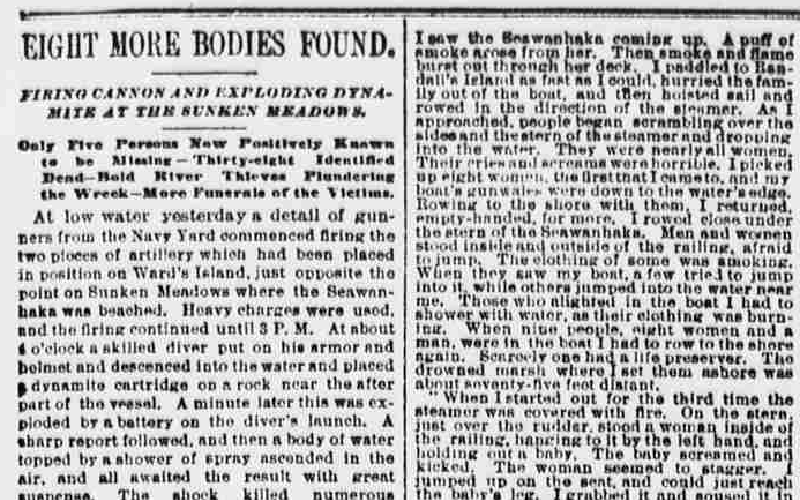
EIGHT MORE BODIES FOUND
FIRING CANNON AND EXPLODING DYNAMITE AT THE SUNKEN MEADOWS.
Only Five Persons Now Positively Known to be Missing—Thirty-eight Identified Dead–Bold River Thieves Plundering the Wreck–More Funerals of the Victims.
At low water yesterday a detail of gunners from the Navy Yard commenced firing the two pieces of artillery which had been placed in position on Ward’s Island, just opposite the point on Sunken Meadows where the Seawanhaka was beached. Heavy charges were used and firing continued until 3 P.M. At about 6 o’clock a skilled diver put on his armor and helmet and descended into the water and placed a dynamite cartridge on a rock near the after part of the vessel. A minute later this was exploded by a battery on the diver’s launch. A sharp report followed, and then a body of water topped by a shower of spray ascended in the air, and all awaited the result with great suspense. The shock killed numerous fishes, whose bodies soon floated on the surface, but had no other immediate effect. The diver then descended and made a complete search under the port wheel and along the submerged hull to the rudder and beyond. Up to 8 1/2 o’clock, when work was discontinued, he discovered no bodies, but had brought up numerous articles of clothing. These were a brown and white checked calico or gingham cheque, with agate buttons, belonging to a girl or small-sized woman; a printed bandanna shawl, a woman’s white undergarment, a man’s black travelling cap, a set of shawl or coat straps, and a pillow case. The search will be resumed to-day, and it is probable that the company will send a force of men to tear off and remove all that part of the guards, rails, or hull [unclear] under which there is the slightest possibility of a body being found. Superintendent Kirk of the company was up with a steam tug yesterday endeavoring to remove the port wheel, but the handling bolts kept it in position, and he was compelled to wait for more effective appliances. The report of a woman’s body having been seen under the wheel may not prove true, the diver yesterday having made a fruitless search for it.
A number of the relatives of missing persons who have been at the scene of the wreck since last Tuesday morning continued their sad search yesterday, and received much sympathy. Commissioner Brennan took charge of the articles recovered and conveyed them to the Ward’s Island Morgue. It is thought that the firing and explosion of a dynamite cartridge, though not immediate in their effects, may cause bodies to rise later, which will be found according as the tide has taken them to-day. Should no more be found it will be an indication that the rest of the missing are either pinned under the wreck or actually burned up.
River thieves made their appearance again yesterday, the force of police inadequate to effectually drive them away. One of them was so bold as to actually steal an acid cup from the diver’s launch, full of men.
Capt. Smith and Mrs. Myers, Miss Diller, and Miss Wylie still remain at Randall’s Island Hospital. Capt. Smith was quite cheerful yesterday. He said he slept several hours the night previous and was in much less pain. Mrs. Myers and Miss Diller are doing well, but Miss Wylie continues quite prostrated. The body of Mr. Rauscher is still at Ward’s Island Hospital.
Louisa Schneider of Canarsie, L.I., reported yesterday at the Morgue that her sister Mary, 19 years old, took passage on the Seawanhaka last Monday afternoon, and that she has not since been heard from. The description will be found in the list of the missing.
Four bodies were brought to the New York Morgue yesterday, three of which were identified as having been victims of the disaster and the fourth is supposed to be. One was that of Hiland R. Hulburd of Great Neck. It was removed by the relatives. The body was found in Hell Gate and taken to Ward’s Island, whence it was brought to the Morgue.
Another body was that of Daniel Moore of 425 West Twenty-sixth street. It was found in the Harlem River, near the foot of 136th street. On its arrival at the Morgue, the widow was sent for by Assistant Keeper Joseph Fogarty, who recognized it from the description in the Morgue books. It yet remains at the Morgue.
The body of the colored girl, Jennie Jones, daughter of Charity Jones of 109 West Twenty-sixth street, was recognized at the Morgue by the mother, who was so prostrated by grief that she had to be carried to an inner room, where restoratives were administered. She cried again and again the it was the only child left her, and that now she had nothing to live for. Mother and child leaped off of the burning boat together, but they were separated. When the mother was rescued the child could not be found.
The fourth body was that of a tall man will full dark whiskers. Only the shirt, trousers, and shoes, (elastic gaiters) were on the body. The trousers, which were wet, were of a dark gray color with small stripes. There was a large scalp wound on the back of the head. It appeared as if the man had been attempting to strip off his clothes when he was drowned. Assistant Keeper Fogarty thought there was sufficient resemblance to the description in the books of John Wright, restaurant keeper of Glen Cove dock, to justify him in telegraphing Mrs. Johnson of that place, to whom information of the missing man was to be sent. The description of John Wright is as follows: “Fifty-three years old, six feet high, slender, dark complexion, dark hair mixed with gray, full dark whiskers mixed with gray, check suit, white shirt, Masonic pin on the vest.” There is no hair on the head of the body, but its removal is possibly accounted for by the action of the water.
Two bodies were found yesterday on the Brooklyn river front. Night watchman A.P. Peterson of Pinto’s stores found one floating in with the tide at 5:30 A.M. and recovered it. This body was last evening identified as that of Horatio W. Mills of Smithtown, L.I., by his brother, Alfred I. Mills, who knew nothing beyond the fact that his brother was on board of the ill-fated vessel.
The other body was picked up at 9 A.M., off Martin’s stores. It was that of a man of stout build, about 35 years old, five feet eight inches high with dark brown hair and side whiskers. Mr. O.H. Schreiner of 51 Cambridge place, Brooklyn, last evening identified the body as that of his brother, Horace A. Schreiner, bookkeeper for Minford, Thomson & Co., 90 Wall street.
The body of Aneta Reynes, niece of Reynes Brothers of 46 Exchange place, was found yesterday in the East River, at Flood Rock, and taken to the Coroner’s office at Long Island City.
The body of ex-Assemblyman Joseph I. Stein was found yesterday afternoon at Strong’s dock, Flushing Bay, wedged in between two rocks. The body was dressed in a blue diagonal suite. There were found in the pockets a gold watch, diamond ring, four pocketbooks, one containing [ten?] dollars, steamer tickets, professional cards, two safe keys, and a silver match box, with initials. Lawyer Van Nostrand identified the remains. Judge Lawrence held an inquest, and the body was removed to an undertaker’s. The remains will be brought to this city to-day. The funeral will take place to-morrow at 9 A.M. from the house 262 East Fifty-second street.
The Health Department was notified yesterday that a number of the Seawanhaka dead, whose bodies were found floating in the East River, had been removed to the Long Island shore in place of to the New York side of the river. It was said that some of the Long Island coroners who are still paid on the fee system, have induced persons to engage in these transactions by the promise to share the fees with them. Superintendent Wailing has ordered the Harbor and Harlem police to arrest such persons, their actions being in violation of the Health code provisions prohibiting the removal of dead bodies without a permit.
THIRTY-EIGHT DEAD, FIVE MISSING.
The list of dead recovered and identified now numbers thirty-eight. The bodies of seven of the thirteen missing person named in yesterday’s Sun were recovered and identified yesterday. They were the bodies of ex-Comptroller of the [Carrency?] Hiland R. Hurlburd of Great Neck; Daniel Moore, laborer, of 425 West Twenty-sixth street; Jennie Jones, a babe, of 109 West Twenty-sixth street; Aneta Reynes, 14 years old, niece of Reynes Brothers, 46 Exchange place; Horace Schreiner, bookkeeper for Minford, Thompson & Co., 90 Wall street; ex-Assemblyman Joseph I. Stein, 202 East Fifty-second street; John Wright, Glen Cove. The body of Horatio W. Mills, Smithtown, L.Il, who had not heretofore been reported missing, was also found.
Mrs. Ann Hall of Bayville, Long Island, who was reported missing by a neighbor, was not on board the boat and William Nichols of Sea Cliff is at home uninjured.
The changes, therefore, leave five missing persons. Their names are as follows:
Aucaigne, Mrs. Minnie, 3[0?]4 West Thirtieth street.
Banks, Frederick B., Norwalk, Conn.
Palmer, Mary, of the Sea Cliff House.
Smith, M. M. N. of Great Neck.
Schneider, Mary, aged 19, 5 feet 7 inches high, brown eyes, blue suit, elastic gaiters, blue stockings, black hat turned up to the left side, gold ring, handkerchief and underclothing marked with her name. Information should be sent to her sister, Louisa Schneider, Canarsie, Long Island.
A DISABLED RESCUER.
John Henry Bush, for many years a waterman on the upper part of the East River, yesterday told the story of his success in saving life at the burning of the Seawanhaka. His arm was bandaged and his left hand was in a sling. His wounds cannot be healed in less than six weeks. He is poor, and has a wife and two children. He said: “I was rowing with my wife, who is in delicate health, and our two children, in a small boat near Hell Gate, when I saw the Seawanhaka coming up. A puff of smoke arose from her. Then smoke and flame burst out through her deck. I paddled to Randall’s Island as fast as I could, hurried the family out of the boat and then hoisted sail and rowed in the direction of the steamer. As I approached, people began scrambling over the sides and the stern of the steamer and dropping into the water. They were nearly all women. Their cries and screams were horrible. I picked up eight women, the first that I came to, and my boat’s gunwales were down to the water’s edge. Rowing to the shores with them, I returned empty-handed, for more. I rowed close under the stern of the Seawanhaka. Men and women stood inside and outside of the railing, afraid to jump. The clothing on some was smoking. When they saw my boat, a few tried to jump into it, while others jumped into the water near me. Those who alighted in the boat I had to shower with water, as their clothing was burning. When nine people, eight women, and a man, were in the boat I had to row to the shore again. Scarcely one had a life preserver. The drowned marsh where I set them ashore was about seventy-five feet distant.
“When I started out for the third time the steamer was covered with fire. On the stern, just over the rudder, stood a woman inside of the railing, hanging to it by the left hand, and holding out a baby. The baby screamed and kicked. The woman seemed to stagger. I jumped up on the seat, and could just reach the baby’s leg. I grabbed it and doused it in the water. The skin on its arms, stomach, and legs was burned. I don’t know whether it lives or not. The woman was Mrs. Catherine Rauscher of 436 West Fifty-third street. On the way back I picked up a 3-months-old baby, floating face downward. Putting both babies in the bottom of the boat, I rowed ashore, not heeding those with life preservers on in the water. On my fourth and last trip, I picked up two women, each about 30 years old and wearing silk and jewelry. They died before reaching shore.”
Bush rescued from drowning a man named Amos in Flushing Bay in 1879, and excursionist in 1876, and a man in 1874 off 125th street. He says that he is destitute and burdened with family cares.
Among the passengers on the Seawanhaka was Mr. H.V. Duryea, father of Wright Duryea, President of the Glen Cove Starch Manufacturing Company. Mr. Duryea is over 80 years old, and has had one hand amputated. While the excitement was at its height, he became separated from his son, George Duryea, and another gentleman, who were with him, and stood helplessly among the passengers at the stern of the boat. One of the lady passengers, noticing that he had no life-preserver, asking him why he did not secure one. He replied by showing her his disabled arm. Instantly, she volunteered to aid him, and carefully tied a life preserver about his body. When he got into the water he found that his life-preserver was too low down, and tended to cause his head to go under water. Others where were floating near kindly helped him until the boats arrived. Mr. Duryea advertises to-day for the name of his fair benefactor. Mr. George Duryea jumped off the bow, and found his father on Randall’s Island.
BURIAL OF THE VICTIMS.
In accordance with a wish expressed some time ago by the Rev. Dr. J.W. Diller, one of the victims of the Seawanhaka disaster, when he thought he was about to die, a communion service was held yesterday morning in St. Luke’s Episcopal Church, and about 500 persons who had been his parishioners partook of the communions, which was administered by the Rev. George R. Van De Water, rector of the church, the Rev. Dr. Samuel Haskins, Dr. D.V.M. Johnson, and the Rev. Mr. Penson. As Dr. Diller also had requested that the poor of the parish should be remembered at the communion service, a collection was taken up in their behalf. The funeral services were held in the church in the afternoon, when the edifice was crowded, and a large number of persons stood outside. A large number of the clergy of the diocese, in their roles of office, moved in the procession from the vestry to the gate of the church, where they met the relatives of the dead preacher. As they marched into the church, where the surpliced boy choirs from St. Mary’s and St. Luke’s Episcopal Churches sang “Abide with Me.” The body was enclosed in a cloth-covered coffin, which rested on pedestals in front of the altar. After the ritual services, Bishop Littlejohn spoke briefly of the long labors and signal virtues of the dead pastor, and the Rev. Dr. Drowne of Garden City gave a sketch of Dr. Diller’s life. Dr. Drowne concluded by reading a series of resolutions which had been adopted by the clergy of the diocese. The interment was in Mount Olivet Cemetery at Maspeth, Queens County, L.I. Among the mourners at the funeral were the Sisters of St. Luke’s Hospital at Albany avenue and Herkimer street. The memorial sermon in connection with Dr. Diller’s death is to be preached on Sunday next by the Rev. Mr. Vandewater.
In a vine-covered cottage at 1,350 Pacific street, Brooklyn, the funeral of Mrs. George W. Colton took place yesterday afternoon. Mrs. Colton was drowned while attempting to escape from the burning Seawanhaka. Her body was almost immediately recovered, and, as it lay yesterday in the back parlor of the cottage, no trace of any external injury was perceptible. The body was encased in a black cloth-covered coffin bearing a simple inscription. Although the friends of Mrs. Colton were requested not to bring flowers, many did so, and the coffin was decorated with many very beautiful floral emblems. Dr. Cuthbert Hall read the service. Late in the afternoon the body was taken to Greenwood.
John McGivern, another of the victims, was buried yesterday afternoon, from his late residence at 441 West Twenty-sixth street. McGivern and Thomas Flannigan of 423 West Twenty-sixth street, both laborers, went aboard the unfortunate Seawanhaka in company. Both were drowned.
The funeral of Mary A. Flynn, a maiden lady who was drowned after the Seawanhaka disaster, took place yesterday at 2,249 Second avenue where she resided with her brother, Mr. John Flynn. The attendance was very large and the floral offerings numerous and beautiful. The casket was of chestnut, covered with black cloth, and the plate gave the name and date of death, June 28. Father Trainor, pastor of St. Lawrence Catholic Church in Eighty-fourth street, read the service. He spoke of the deceased as not only having faith, but as being diligent in good works and a very active member of the ladies’ Sodality of his church. The poor, he said, would miss her greatly.
THE INQUEST.
Coroner James Davron of Long Island City took the testimony on Monday night at Astoria of Wallace C. Pendleton, cook on the schooner Sardinian of Rockland, Ma., who said that as the schooner was being towed through Hell Gate to New York, at about 5 o’clock, the Seawanhaka approached in a burning condition, and was about abreast of the inebriate asylum on Ward’s Island and about the middle of the channel, when he saw a man jump overboard. The Schooner’s boat was lowered, and he was saved. It then went after another man, and rescued him. About 300 yards from where the first man was picked up the witness saw a woman, who had been lying sick in the cottage on the Government works at Hallett’s Point, and picked her up. Then picked up another woman. Seeing no one else, the boat made for land, The last woman picked up seemed to be dead. The other woman never spoke after being taken from the water. The first woman subsequently proved to be Miss Mary A. Flynn. The other was afterward resuscitated.
On Tuesday evening, at Long Island City, Coroner Davron took testimony concerning the body of Miss Mary Ann Flynn. P.S. Trainor of 325 East 116th street recognized the body as that of Miss Flynn, who resided at 2,249 Second Avenue. She left home to go and see her uncle at Whitestone. She was about 36 years of age, and was born in New York city.
On Wednesday Coroner Davron took the testimony of Benjamin C. Kirk of Glen Cove, who said that he had been steadily employed for the past two years as superintendent of the Seawanhaka, and had been also so employed irregularly for six years. As he was collecting fares with the clerk he looked into the engine room to see if any passengers were sitting there. There was no sign of fire at this time, but in not more than one minute after he heard an alarm of fire. Went immediately forward again, and saw that the fire was all around the engine room, and under such headway that it would be impossible to extinguish it; closed the gangway doors to prevent a draught, and went to the pilot house, where he told the Captain to run the boat ashore, as she was on fire, and that the flames could not be quenched. The Captain at once headed her for the Sunken Meadows. Witness then went on the promenade deck to assist the ladies and passengers generally to the forward deck as a place of safety until the boat reached the shore. After the passengers were all off the promenade deck it grew so hot that witness could no longer stay there, and, as the boat was ashore, he jumped overboard and aided fifteen or twenty ladies and gentlemen who were in the water. With the assistance of the mate and the clerk, all were rescued who were near the spot. Witness then took a boat, and, as he went ashore, rescued four ladies aft of the wheel, on the same side of the boat, who were hanging on to the guard braces.
James W. Ray of Roslyn, L.I., said that he had been mate of the Seawanhaka for fourteen years, and a dock hand previously for five years. The steamer in that period had sustained but one accident. That was eight or nine years ago, when a cylinder broke. No person was hurt. Mr. Ray then repeated substantially the same account of the recent disaster as had been published as coming from him.
Other witnesses were examined, without eliciting anything new.
— 03 Jul 1880, The Sun, New York NY, p3, nyshistoricnewspapers.org. View largest available size.

MORE FROM THE DISASTER.
THE ACTION OF THE “SEAWANHAKA’s” OWNERS CREATES SURPRISE.
Thirty-Eight Victims Identified So Far–More Being Found Every Day–The Wreck to Be Blown Up, When Still Others Will Come to the Surface.
[By Telegraph to the Utica Observer.]
NEW YORK, July 3.–The bodies of 38 victims of the Seawanhaka disaster have been identified. Only five are now positively known to be missing.
TO BE BLOWN UP.
The work of recover is progressing rapidly. It is stated the company is going to blow up the wreck. This will bring all the bodies to the surface.
COMPETING CORONERS.
Complaints reached the Board of Health today that boatmen were towing bodies from the wreck to the Long Island Shore in order to benefit Queen’s County coroners. The police have been ordered to arrest those found removing bodies from the New York side.
BODIES FOUND YESTERDAY.
The body of a man was picked up at Brooklyn, yesterday. The deceased was about thirty-five years of age and had on a gray tweed suit. In his pocket was found the address of “Mrs. H. W. Thorpe, Scudder House Glenwood, L.I.” A silver watch and $14 in money were also found. The bodies of H. R. Huredurd, Daniel Moore and Jennie Jones, colored, were brought to the morgue from the scene of the disaster, yesterday afternoon. The body found floating at the Atlantic dock, Brooklyn, early yesterday morning, was identified as that of Horatio W. Mills, of Smithtown, L.I., a victim of the Seawanhaka disaster. A second body, which floated in at Martin’s stores, Brooklyn, was identified as that of another victim, Horace H. Schreimer, of Brooklyn.
EX-ASSEMBLYMAN STEIN.
FLUSHING, L.I. July 3.–A body found last evening has been identifies as ex-Assemblyman Joseph J. Stein, of New York. At the Coroner’s inquest the remains were fully identified as those of ex-Assemblyman Stein, and a verdict was rendered that deceased came to his death by drowning.
ESCAPED SAFELY.
COLLEGE POINT, L.I., July 3.–William Nichols, of Sea Cliff, Mrs. D. Meissner, Mrs. Thorp, and Miss Annie Simonson, all of Glenwood, among the missing passengers of the Seawanhaka, were found uninjured, except Mrs. Meissner, who sustained internal injuries.
WHO SAVED H. W. DURYEA!
NEW YORK, July 3.–The address of the lady on the Seawanhaka who secured a life preserver on the person of H. W. Duryea, and assisted him to escape the terrible death, is advertised for. Duryea is 82 years of age and one-armed. He is the senior member of a starch manufacturing firm at Glen Cove. While he was standing on the hurricane deck with a life preserver in his hand, a young lady asked him, “Why do you not adjust it?” “I cannot,” was the reply, “I am one-armed.” She adjusted the preserver and Duryea, jumping from the burning steamer, was picked up by a boat from the Granite State.
NON-ACTION OF THE OWNERS.
NEW YORK, July 3.–The conduct of the owners of the Seawanhaka is wondered at by those who have been engaged in the search for the bodies at the wreck. All that has been done toward recovering the remains of the victims of the terrible disaster has been accomplished through the Commissioners of Charities and Corrections, by divers employed by private individuals or by boatman stimulated by the offer of large rewards for securing certain bodies.
— 03 Jul 1880, Utica Daily Observer, Utica NY, p1, nyshistoricnewspapers.org. View largest available size.
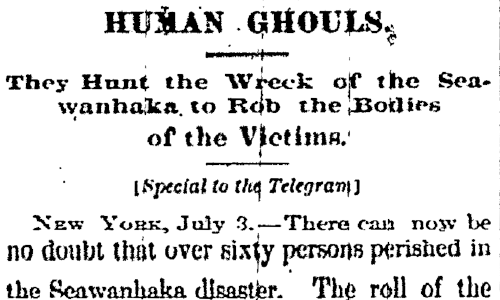
HUMAN GHOULS.
They Hunt the Wreck of the Seawanhaka to Rob the Bodies of the Victims.
[Special to the Telegram]
New York, July 3.— There can nosy be no doubt that over sixty persons perished in the Seawanhaka disaster. The roll of the known dead already published exceeds half of that number, and it is unreasonable to suppose that the thirty-five persons who are missing would continue to absent themselves from their grief-stricken families were they living. The search for the dead continues with unabated vigor. At low water in the morning boatmen engaged at the wreck, while probing the bottom of the river with their oars, drew up a piece of brown calico, which was found ta be a portion of a woman’s dress. It was disclosed, by further search, that three bodies, supposed to be women, lie imbedded in the mud under the stern of the Seawanhaka.
THE FRIENDS OF THE DEAD
and the residents of Harlem denounce in the strongest language the conduct of the scoundrels who have peen prowling around the ill-fated vessels night and day, and the authorities who have permitted them to reap gain by robbing the dead receive a full share of condemnation. The hardihood of the thieves will be understood from a single case. While Isaac Stern was searching on Wednesday for his fiend, ex-Assemblyman Stein, he brought to the surface the body of Mrs. Lizzie Aikens, and two forbidding looking fellows rowed over and attempted to capture it, and would have succeeded had it not been for the interference of Captain Paddy Grace of the little steamer Refuge. When the body was brought safely ashore and placed in the hands of responsible parties, Stern addressed.the thieves and offered to give them $100 if they would assist him to find Mr. Stein’s body. He states that their reply was: “To h— with the bodies; we’re looking for jewelry and money.”
SEVERAL OF THESE THIEVES,
known in Harlem as the “Rattle Row Gang,” have recently appeared on the streets dressed in new outfits, and one of them yesterday sold, a gold watch in Harlem for $16. Yesterday three officers of the Harbor Police appeared at the wreck, and the thieves beat a hasty retreat, but, no doubt, they will return later. They are armed to the teeth, and it is about time that decent people should understand whether or not the people are able to suppress them. Commissioner Brennen brought two heavy cannon from Blackwell’s Island yesterday, and had them placed in position on the low ground on Ward’s Island, opposite the wreck. He gave orders that they be fired off at regular intervals during the night, in the hope of bringing the dead to the surface of the water; and while this is being done a number of row-boats will patrol the river. As the keel now lies it is impossible to bring them to the surface. One body also lies under the port paddle-wheel. These bodies can not be recovered till the wreck is removed or broken up. The work goes slowly on, and it may be a week before all the bodies are brought to the surface.
— 04 Jul 1880, Sunday Morning Telegram, Elmira NY, p1, nyshistoricnewspapers.org. View largest available size.
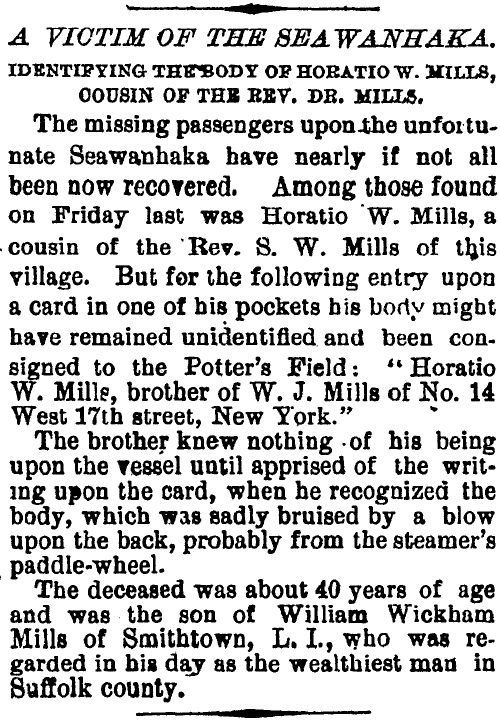
A VICTIM OF THE SEAWANHAKA.
IDENTIFYING THE BODY OF HORATIO W. MILLS, COUSIN OF THE REV. DR. MILLS,
The missing passengers upon the unfortunate Seawanhaka have nearly if not all been now recovered. Among those found on Friday last was Horatio W. Mills, a cousin of the Rev. S. W. Mills of this village. But for the following entry upon a card in one of his pockets his body might have remained unidentified and been consigned to the Potter’s Field: “Horatio W. Mills, brother of W. J. Mills of No. 14 West 17th street, New York.”
The brother knew nothing of his being upon the vessel until apprised of the writing upon the card, when he recognized the body, which was sadly bruised by a blow upon the back, probably from the steamer’s paddle-wheel.
The deceased was about 40 years of age and was the son of William Wickham Mills of Smithtown, L. 1, who was regarded in his day as the wealthiest man in Suffolk county.
— 06 Jul 1880, The Evening Gazette, Port Jervis NY, p1, nyshistoricnewspapers.org. View largest available size.
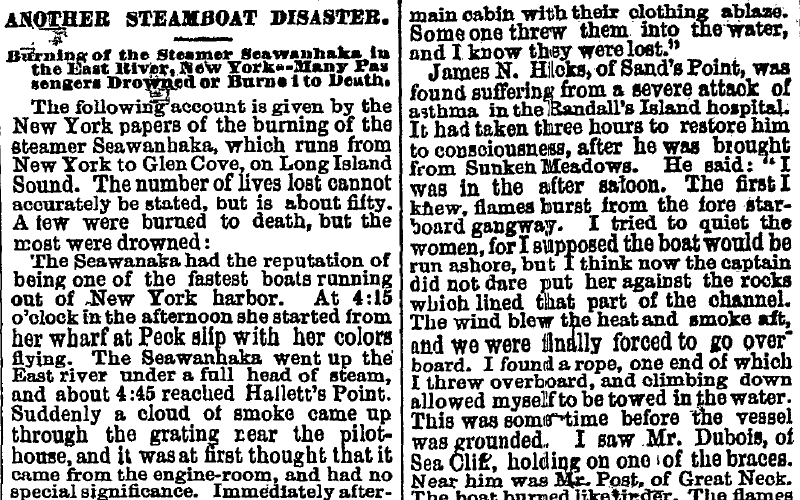
ANOTHER STEAMBOAT DISASTER.
Burning of the Steamer Seawanhaka in the east River, New York–Many Passengers Drowned or Burned to Death.
The following account is given by the New York papers of the burning of the steamer Seawanhaka, which runs from New York to Glen Cove, on Long Island Sound. The number of lives lost cannot accurately be stated, but is about fifty. A few were burned to death, but the most were drowned:
The Seawanaka had the reputation of being one of the fastest boats running out of New York harbor. At 4:15 o’clock in the afternoon she started from her wharf at Peck slip with her colors flying. The Seawanhaka went up the East river under a fall head of steam, and about 4:45 reached Hallett’s Point. Suddenly a cloud of smoke came up through the grating rear the pilot house, and it was at first thought that it came from the engine-room, and had no special significance. Immediately afterward flames were seen around the pilothouse. Captain Charles P. Smith was in the wheel-house, and seeing the danger turned his vessel toward Ward’s Island, intending to beach her there. Somebody cried “The ship’s on fire!” and a panic started. A rush was made for the lockers in which the life preservers were kept. Most of the men retained their presence of mind and helped the officers of the steamer in supplying the women and, children with life-preservers. Captain Smith shouted from the wheel-house to the passengers to keep order, and his assistants tried to restore order and were assisted by many of the passengers. The crew meanwhile got the fire extinguishers and turned the streams on the blazing woodwork, but to little purpose. The fire spread aft along the port side toward where the passengers were standing and drove them forward. On the starboard side there was still a space which the fire had not touched. Along this narrow space the passengers hurried to the forward part of the boat. By this time all hope of saving the vessel had been abandoned, and those on board anxiously watched the spot where Captain Smith intended to ground his vessel, The moment he realized that the fire could not be extinguished, Captain Smith had ordered his boats lowered, and had headed the vessel under a full head of steam toward the shallow water at the northern end of Ward’s Island. The steamer Granite State was behind the Seawanhaka when she caught fire, and many of the passengers who jumped overboard were picked up by this vessel. The tug Refuge, of the emigration department, General Newton’s steam launch, and a score of rowboats, which surrounded the Seawanhaka. At the upper end of Ward’s Island, where it was intended to strand the vessel, it was discovered that the water was not sufficiently shallow, and the vessel’s head was turned to the sunken meadows which are south of Randall’s Island. There the Seawanbaka was run aground, and the work of saving the passengers begun. Several of the passengers remained on the Seawanhaka until they were driven away by the flames; one man and a child held on to the guard rail until it was burned away, and they then fell into the river.
Mr. C. A. Dana, the editor of the New York Sun, Doctor Draper, his son-in-law, and Mr. S. L. M. Barlow, jumped into the water together and, being expert swimmers, all reached the Long Island shore in safety.
Narratives of Survivors.
Mr. Mitchell Cook, of 58 Broadway, was badly scalded about the neck, face and hands. Mr. Cook is a quiet, unassuming, determined-looking man. He said: “We left Peck slip at 4:15. In our party was Mrs. Thorpe, of Glenwood, and S. W. Norris, of this city. The Seawanhaka made good time to Thirty-third street. There she took aboard a number of passengers. Among them was a tall, fine-looking old gentleman, who was being led by his daughter. We left Thirty-third street on time, and everything seemed to be going along quietly, until, all of a sudden, the Seawanhaka gave a series of low groanings, followed by thuds. The passengers noticed these, and everybody seemed to ask the other: ‘ What’s that?’ I was at the time sitting in the main cabin. I at once walked out to the bow of the boat, and I then saw Captain Smith standing in the pilot-house. He was blowing alarm signals. I knew they were alarm signals, from my knowledge of steamers. Suspecting at once that there was danger threatened I returned to my friends. As I passed directly amidships I saw smoke issuing through the cracks of the main saloon leading from the engine-room to the pilot-house. I then knew that the boat was afire, and I rushed to the Long Island side of the boat to see what chances there were for saving my friends if the worse came to the worse. I noticed that the captain was steering the Seawanhaka to the Granite City which was coming up, and was lying to. At the same moment, saw a thin, long, white tongue of flame shoot up to the upper decks. I knew then that the Granite City could not assist us. The Granite City evidently guessed as much, for she turned around, and the Seawanhaka was gone. I sprang to the New York side of the boat. This was at the moment the Seawanhaka was just between Randall’s Island and Ward’s Island. At that very Moment the flames shot upward, and the boat was afire. A great number of male passengers at this very moment game running up to the bow of the boat. Many of them seemed frantic, and all had life-preservers on. At that time the men passengers who had life-preservers began jumping into the water, and swimming to shore. They kept steering the boat to the bar opposite Randall’s Island. There the water is low, and the bar is covered with grass. As the Seawanhaka touched the bar the flames burst all over the boat, and before I knew it I was surrounded by fire. Then it was that I sprang overboard. Just as I did so, an old lady, the mother of the freight clerk, ran up to a gentleman and exclaimed: ‘For God’s sake, sir; help me. I am old, and cannot save myself.’ The gentleman pushed her back, saying: ‘This is not a moment to save; it is every one for himself,’ and he leaped overboard. I called out to the old lady: ‘If you will jump overboard I will save you.’ Her dress at that moment was afire. She jumped into the water at the very moment I did, and I caught her. I was swimming to shore with her when one of the officers of the boat came toward me and we landed her safely. After resting a few minutes, being a good swimmer, I took off my clothes and, with two life preservers, I swam back to the boat. When I got there I saw a young lady standing with her father on tho burning steamer. It was the same one we had noticed coming aboard leading him. She was shrieking: ‘Save my father! Save my poor father.’ She had her arm around is neck, but he seemed to cling firmly to a pillar. It was the most heartrending sight I ever witnessed. The old man clung to the post, while his daughter tried all she could to drag him away. At that very moment she seemed to be surrounded by fire, and the old man’s clothing was burning. He seemed paralyzed and unable to move. I and others called to the girl to jump into the water, that we would save both. She did not seem to know what to do, until at last her dress caught fire. She sprang at her father, kissed him, and a moment after she struck the side of the boat, and fell limp in the water. I caught her by the hair and struck out. I got assistance, but as we turned to the boat we saw the poor old man still there. The man who was assisting me threw up his hands and went down. I got the young lady ashore, and she was at once taken to the Randall’s Island hospital. She did not see her father disappear. I swam again to the boat. This time I found a lady throwing up her hands, and caught hold of her, and, with assistance, took her to shore. Dr. Carroll, of Randall’s. Island, swam out and picked up a child. The poor little thing was dead and terribly burned. Among the first I saw die were two little children, who were running in the main cabin with their clothing ablaze. Some one threw them into the water, and I know they were lost.”
James N. Hicks, of Sand’s Point, was found suffering from a severe attack of asthma in the Randall’s Island hospital. It had taken three hours to restore him to consciousness, after he was brought from Sunken Meadows. He said: “I was in the after saloon. The first I knew, flames burst from, the fore starboard gangway. I tried to quiet the women, for I supposed the boat would be run ashore, but I think now the captain did not dare put her against the rocks which lined that part of the channel. The wind blew the heat and smoke aft, and we were finally forced to go overboard. I found a rope, one end of which I threw overboard, and climbing down allowed myself to be towed in the water. This was sometime before the vessel was grounded. I saw Mr. Dubois, of Sea Cliff, holding on one of the braces. Near him was Mr. Post, of Great Neck. The boat burned like tinder. The flames completely divided the boat in two parts. I think there must have been four or five hundred on board, and it seems to me that I saw two or three hundred in the water altogether. Some had life-preservers and some had not. The crew and Captain Smith behaved nobly. A deckhand called Dennis and a colored man named Nathan, and Mr. Field and Superintendent Kirk were especially cool. The Granite State, a Hartford steamboat, hovered around us.”
Charles Abeel, one of the firemen of the boat, was found on the pier at the foot of Peck slip, from which the Seawanhaka started at 4:15 o’clock in the afternoon. He said: “We made our landing at the foot of Thirty-third street at 4:30 o’clock, and it was about fifteen minutes later when we reached Little Hell Gate. I was sitting in the wing or port gangway having started the bilge pump, I heard a noise, and on looking around saw flames coming out of the fire-room. I got up and tried to make my way into the fire-room, but the flames were too much for me. We were just off Randall’s Island, and running forward I shouted to the captain, who was at the wheel, to head her for the shore, but he shouted back that he could not. I then ran into the cabins forward and urged the steward and passengers to save themselves. They did not suspect the vessel was on fire then, as no smoke or flame was blown in that direction. At that time the wood work of the vessel about her center was burning like tinder, and the flames were spreading toward both ends of the boat. There were probably about three hundred persons on board. Men were jumping from the hurricane deck into the water, and a large number of frightened children and women were huddled near the stern of the boat. I climbed over the rail near the bow, and several men almost jumped upon me before I took to the water to save myself. I found a life-preserver floating near me, and was going to put it on when a man clutched it, and I, knowing I could swim and thinking he could not, let him have it and swam for Ward’s Island, which I reached, and then helped man a boat and assisted in picking up the passengers in the water. The Seawanhaka was finally beached, but soon burnt to the water’s edge. Captain Charles P. Smith was at the wheel, and stuck to his post to the last. His face and body were badly burned. Small boats came to the rescue from every direction. The steamboats Granite State, bound for Hartford, the Osseo, the Minnehannock and the Sylvan Glen had boats manned and sent to our assistance. Many of the children on board had their clothing catch fire, and some of them were severely burned. A lamp which I carried in my hand into the tank-room, which is back of the fire-room, and separated by a board partition, I brought back into the fire-room and put it down. I am sure the fire could not have originated from the lamp, as the oil would not explode nor burn without a wick. Engineer Weeks put on a full head of steam, I am told, in response to an signal from the captain, and then climbed up among the machinery and was seen standing on the upper deck trying to raise the valve so that the steam could escape and an explosion be averted. We never carried over thirty four pounds of steam. Engineer Weeks’ son was fireman on the boat, and at the time the fire started was watching the steam and water indicators. The only members of the crew I understand are missing is Josiah Hasbrouck, the cook, and his grandson, Charles Hasbrouck, who was employed on the boat. We had crew of about four deckhands, one deck-boy, an engineer, two firemen, the captain, a clerk, a wheelsman, a superintendent, a porter, a stewart and the cook. The crew did their duty and few of them lost their presence of mind. You can imagine how cool they were when the clerk, who was collecting fares, as soon as he realized the boat was on fire, returned to his office and secured all the money he had left there. Among our passengers were Richard O’Gorman and one or two of the Harpers—I mean the publishers. The vessel burned like tinder after once the flames started. Some of the sights were pitiful. Morris, our porter, saw a child lying on its back and was going to jump overboard to save it, when a frantic woman clutched his arm, and saying: “You are a strong man and I a woman without any friends on board. For God’s sake help me.” He left the child to its fate, I believe, and saved the woman. The only one of the Seawnanhaka’s boats got out was one which had a canvas fastened over it. After the canvas was got off, the body of a child about two years old was found lying in some water in the bottom of the boat. Nobody seemed to know how it got there. After I got on Randall’s Island I was almost exhausted, but the doctors soon revived me by pouring some liquor down my throat A lady was climbing down a ladder leading from the promenade deck to the main deck, but as the ladder is a pretty hard thing for a man to get down on at any time, she fell into the gangway amid the flames. Myself and about half a dozen others rescued her, and I burnt my hand. I saw a butcher who belongs either at Great Neck or Sand’s Point jump overboard with an asparagus box. The last I saw of him he was going under the wheel. Several others who went over forward also went under the paddle-wheels.”
— 08 Jul 1880, Commercial Advertiser, Potsdam Junction NY, p4, nyshistoricnewspapers.org. View largest available size.

A VICTIM OF THE SEAWANHAKA DISASTER.
Horatio W. Mills, of Smithtown.
The funeral services over the remains of the late Horatio W. Mills, one Of the victims of the Seawanhaka disaster, took place Sunday, July 4, at St. James Episcopal Church, Smithtown. He was the son of the late Wm. Wickham Mills, of the former place. This sad event occurred during the absence of his family, who were not aware of his being on the boat until they were notified, Friday afternoon, that his body had been found early that morning floating off Brooklyn. He was a very fine swimmer, and would doubtless have saved himself if he had not been so badly injured by the wheel.
Mr. Mills was educated as a lawyer being a graduate of Columbia College Law School, and was endowed with talents of the highest order. He was a man of the strictest integrity, possessing one of the noblest and most generous of spirits, He did not follow his profession, but spent most of his time in traveling. His sad end has cast a deep gloom over his many friends and relatives, who mourn bis untimely fate.
CHAUNCEY HAWKINS.
WHEN we stated in our report of the disaster to the Seawanhaka, that Chauncey Hawkins was among the lost, we marked the similarity of names but cherished the doubt of its being our quiet but pleasant friend of that noted resort for Long Island Ship Masters, 107 South street. It proved to be a fact however, and a sad one too. Mr. Hawkins was favorably known to a host of Long Island people, and was in fact one of them. For some 14 or more years he has been connected, with the store of Mr. Mills, and during a large part of that time be occupied a very responsible position, being in charge of all orders for ship stores. He Was always obliging and ever faithful to his employers interests. He will be greatly missed not only by his employers, but by those who frequent the place. Not to find Chauncey Hawkins at his post was an exception. He will be greatly missed by all.
— 10 Jul 1880, South Side Signal, Babylon NY, p2, nyshistoricnewspapers.org. View largest available size.

IN THE EAST RIVER, off Randall’s Island, suddenly, at the burning of the steamer Seawanhaka, Horatio W. Mills, son of the late Wm. Wickham Mills of Smithtown.
— 10 Jul 1880, South Side Signal, Babylon NY, p2, nyshistoricnewspapers.org. View largest available size.

FUNERAL SERMON OF CHAUNCEY HAWKINS.
The Rev. J. Hyatt Smith, of the Lee avenue Baptist Church, preached the funeral sermon of the late Chauncey Hawkins, one of the trustees of that church, and who was one of the victims of the wrecked Seawanhaka. Mr. Smith’s subject was “The Voices of God’s Providence in the Destruction of the Seawanhaka.” Mr. Hawkins was a man of middle age, The bodies of hie wife end child were recovered immediately after the disaster, but his was not found for some days afterward, His funeral took place on Sunday, a week ago.
— 12 Jul 1880, The Brooklyn Daily Eagle, Brooklyn NY, p3, newspapers.com. View largest available size.

Swimming Versus Dancing.
(N. Y. Mail)
The recent disasters on neighboring waters by which large numbers of persons were lost and the frequent drowning accidents at the seaside among bathers who have not been taught the art of keeping themselves afloat, illustrate forcibly the necessity of learning to swim. The fearful mortality attending the Narragansett an Seawanhaka accidents was mainly due to the ignorance among the majority of those throwing themselves in the water of the easily acquired art of swimming, while those who were saved even when girdled with a life-preserver owe their deliverance from a watery grave to the kindly assistance of swimmers.
Boys and girls should be taught to swim long before they are allowed to devote themselves to mathematics, ceramics, philosophy or dancing, which last is considered an indispensable concomitant to the education of a fashionable child. It is safe to state that among a hundred young men capable of leading the German with skill and grace there are not half a dozen who could save their own lives if suddenly plunged into deep water.
The proportion of young women more skilled in the saltatory than the natatory art is still greater. If any of these capital dancers were called upon to save the lives of drowning persons they would all probably be powerless, and would themselves perish in their efforts. The swimmers of the Stonington and Seawanhaka found that their skill as such was worth much more to themselves and to society than the first attainments of the most fashionable dancing academy.
Parents and guardians should have their youngest charges taught the art of swimming—should insist upon it. There are several first class swimming academys in New York, and they will have a feeling of safety when their charges are on or near the water to recompense them for their foresight.
— 14 Jul 1880, Daily Morning News, Batavia NY, p1, nyshistoricnewspapers.org. View largest available size.
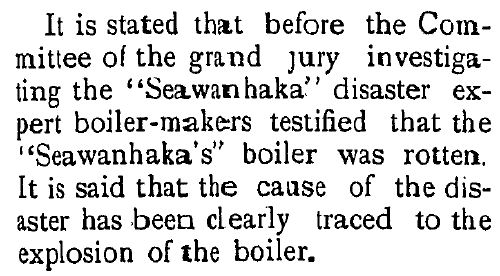
It is stated that before the Committee of the grand jury investigating the “Seawanhaka” disaster expert boiler-makers testified that the “Seawanhaka’s” boiler was rotten. It is said that the cause of the disaster has been clearly traced to the explosion of the boiler.
— 26 Jul 1880, Batavia Daily News, Batavia NY, p1, nyshistoricnewspapers.org. View largest available size.
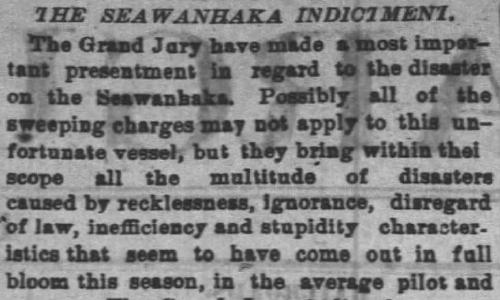
THE SEAWANHAKA INDICTMENT
The Grand Jury have made a most important presentment in regard to the disaster on the Seawanhaka. Possibly all of the sweeping charges may not apply to this unfortunate vessel, but they bring within their scope all the multitude of disasters caused by recklessness, ignorance, disregard of law, inefficiency and stupidity characteristics that seem to have come out in full bloom this season, in the average pilot and master. The Grand Jury indict the owners of the steamboat for neglect and refusal to provide the necessary safety appliances, and charge that by this felonious misconduct many lives were lost. Charles P. Smith, the heroic Captain, is indicted for the same offence, and Mr. Weeks, the Engineer, is indicted for carelessness in the management of the machinery and boilers, with neglect in having the tubes and flues in bad condition, and unsafe for use, and for having inadequate provision to prevent sparks and flames from being thrown from the fire-doors of the boiler. Messrs. Jayne and Craft, the United States Inspectors, are charged with felonious misconduct and willful carelessness and negligence in the performance of their duties in the annual inspection and examination required by law of the steamboat, and with neglect in not having all the requirements of the law in regard to the life-saving apparatus complied with. John K. Matthews and Alexander Cauldwell, United States Inspectors of Boilers and Machinery, are indicted for neglect in their annual inspection and examination, in not discovering the bad condition of the boilers, tubes and flues. Very thorough work is done both in the presentment and indictment, and a warning is given to Government officers, and to steamboat owners and officer such as they may profit by. All of the parties who have been indicted profess to be astonished at the faction of the Grand Jury, express no apprehension of the result, and cannot for the life of them understand why they are made conspicuous in this abrupt manner. Mr. Barlow says the Seawanhaka was the finest boat on the Sound, that the owners did not run her for profit, and did not care whether she paid a dividend or not. She was run to accommodate the owners and their families and friends. At the meeting of the Directors in the spring, he told the manager to be sure that before the Seawanhaka began running she was in perfect trim. He told him to buy the best of everything; not to be afraid to spend money, and to have her thoroughly examined by the United States Inspectors. The manager subsequently told him all that had been done. Government-Inspector Jayne has never been on board the Seawanhaka since he held the office. He accepted the report of his deputies, and signed the certificate. Mr. Craft, who is a practical shipbuilder, says he personally examined the Seawanhaka, and knows she was in excellent shape. The Boiler Inspector says the same thing. It remains for juries to hear and weigh the testimony that will be given on the trials, and determine the responsibility of the parties implicated. There is hardly a steamboat in these waters on which the life-saving appliances are not out of order. This is notably true of the excursion boats. Life preservers are imperfect, and are not in numbers required by law, while the passengers are very often in excess of the limit. It is charged that boats and life-preservers are borrowed from ship chandlers and passed around from one steamboat to another, so that an inspector is apt to find things in good order.
The Presentment of the Grand Jury is a most formidable document, and calls for a thorough revision of the laws, and the establishment of a system in which competent and responsible men shall act officially and be held to a strict accountability to punitive statutes. The Grand Jury declares that the examinations and inspections “are not conducted in a careful and intelligent manner;” that “engineers holding the certificates of the Inspector are incompetent for their several positions, and that the evidence of such Inspector himself shows that he was negligent and careless in granting such certificates;” that the laws regarding hull, boiler, and equipment inspection “are not observed to any degree of accuracy or honest fulfilment,” that vessels absolutely unfit for service are licensed, and that vessels built for still-water service “carry thousands of excursionists many miles out to sea.” The Jury give illustrations of the incomplete manner in which boilers are tested, and declare that under the present system there is mo assurance of security. The Jury say it has been shown to them that an association in England, of many years’ existence, annually insuring 2,500 to 3,000 boilers, has a system of inspection so thorough and exhaustive that there has never been an explosion of any boiler under its charge. They demand that our Government have such a system. They say that after a passenger has bought a ticket on boats run merely for profit, and without regard to law, “he is consigned to the care and protection of incompetent and thoughtless officers, and a cowardly and worse than incompetent crew, who have been employed because they are unfit for other work, and without regard to their character or qualifications.” The Jury denounce the habit of overcrowding boats, and call for a law to punish the pilots, who are actuated by “a dangerous spirit of jealousy,” and whose rivalry and recklessness lead them into the “special amusement of capturing each other’s right of way.” The presentment concludes with a number of recommendations of a practical character, which are calculated to insure the efficiency and competency of crew and the greater safety and comfort of passengers. There is a very profound feeling of alarm and dread in the community, and a very general desire to have a good wholesome example made of some of these maritime daredevils or imbeciles.
— 11 Aug 1880, The Brooklyn Union, Brooklyn NY, p2, newspapers.com. View largest available size.
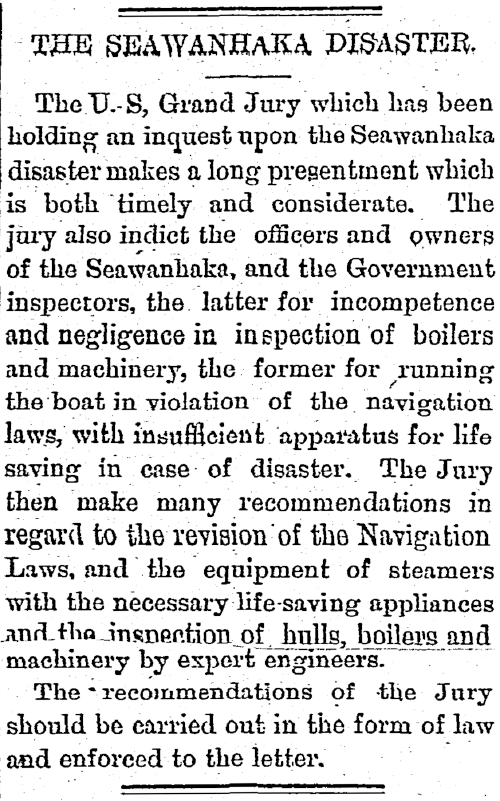
THE SEAWANHAKA DISASTER.
The U.S. Grand Jury which has been holding an inquest upon the Seawanhaka disaster makes a long presentment which is both timely and considerate. The jury also indict the officers and owners of the Seawanhaka, and the Government inspectors, the latter for incompetence and negligence in inspection of boilers and machinery, the former for running the boat in violation of the navigation laws, with insufficient apparatus for life saving in case of disaster. The Jury then make many recommendations in regard to the revision of the Navigation Laws, and the equipment of steamers with the necessary life-saving appliances and the inspection of hulls, boilers and machinery by expert engineers.
The recommendations of the Jury should be carried out in the form of law and enforced to the letter.
— 14 Aug 1880, The Corrector, Sag Harbor NY, p2, nyshistoricnewspapers.org. View largest available size.
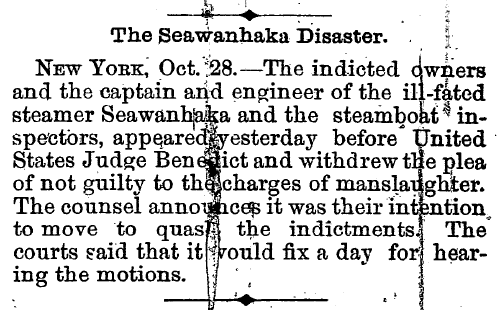
The Seawanhaka Disaster.
New York, Oct. 28.—The indicted owners and the captain and engineer of the ill-fated steamer Seawanhaka and the steamboat inspectors, appeared yesterday before United States Judge Benedict and withdrew the plea of not guilty to the charges of manslaughter. The counsel announces it was their intention to move to quash the indictments. The courts said that it would fix a day for heating the motions.
— 28 Oct 1880, Cuba Daily News, Cuba NY, p1, nyshistoricnewspapers.org. View largest available size.
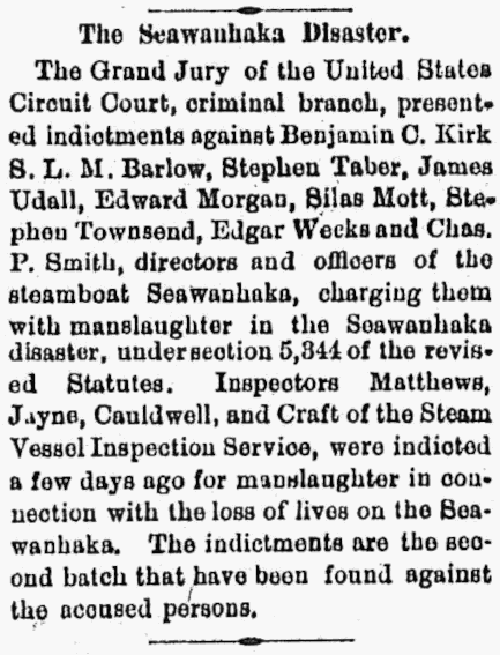
The Seawanhaka Disaster.
The Grand Jury of the United States Circuit Court, criminal branch, presented indictments against Benjamin C. Kirk, S. L. M. Barlow, Stephen Tabor, James Udall, Edward Morgan, Silas Mott, Stephen Townsend, Edgar Weeks and Chas, P. Smith, directors and officers of the steamboat Seawanhaka, charging them with manslaughter in the Seawanhaka disaster, under section 5,844 of the revised Statutes. Inspectors Matthews, Jayne, Cauldwell, and Craft of the Steam Vessel Inspection Service, were indicted a few days ago for manslaughter in connection with the loss of lives on the Seawanhaka. The indictments are the second batch that have been found against the accused persons.
— 11 Dec 1880, The Roslyn News, Roslyn NY, p3, nyshistoricnewspapers.org. View largest available size.